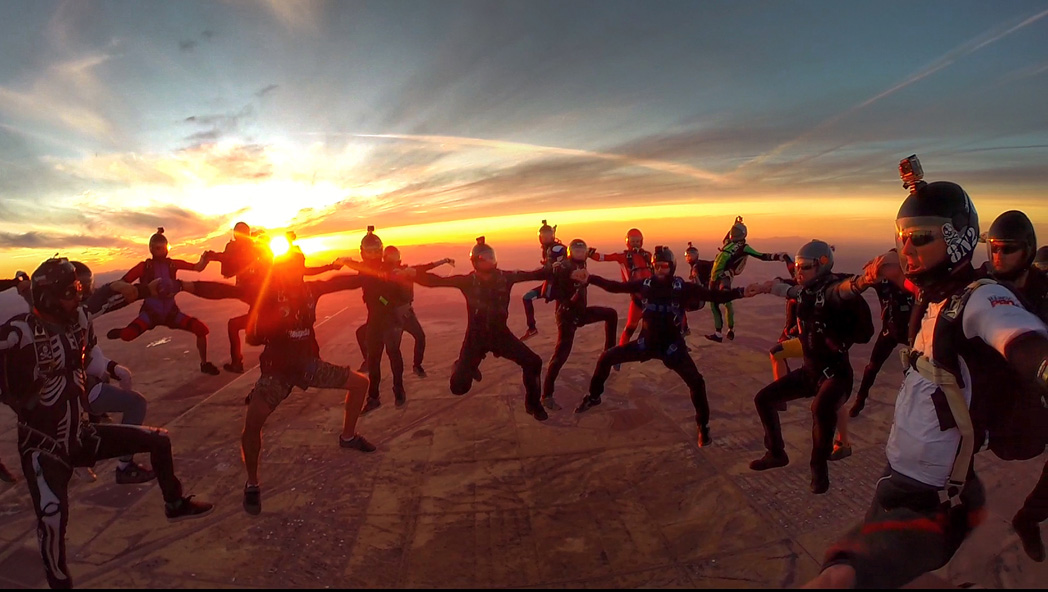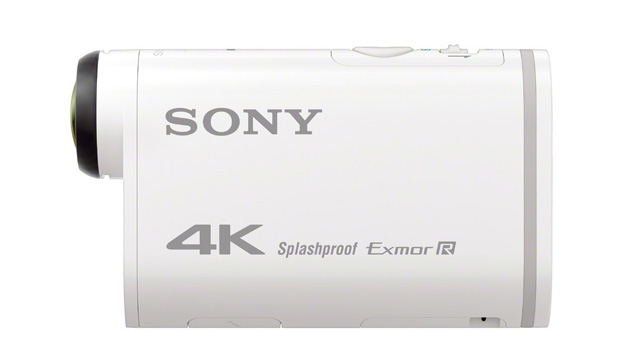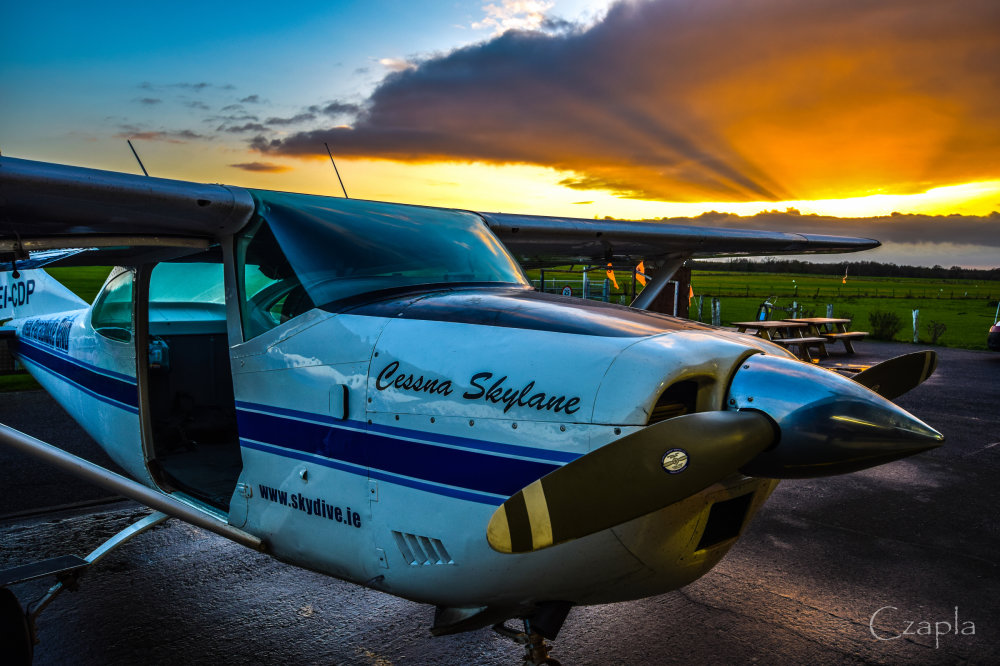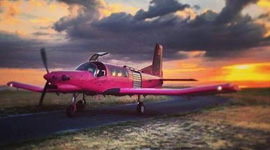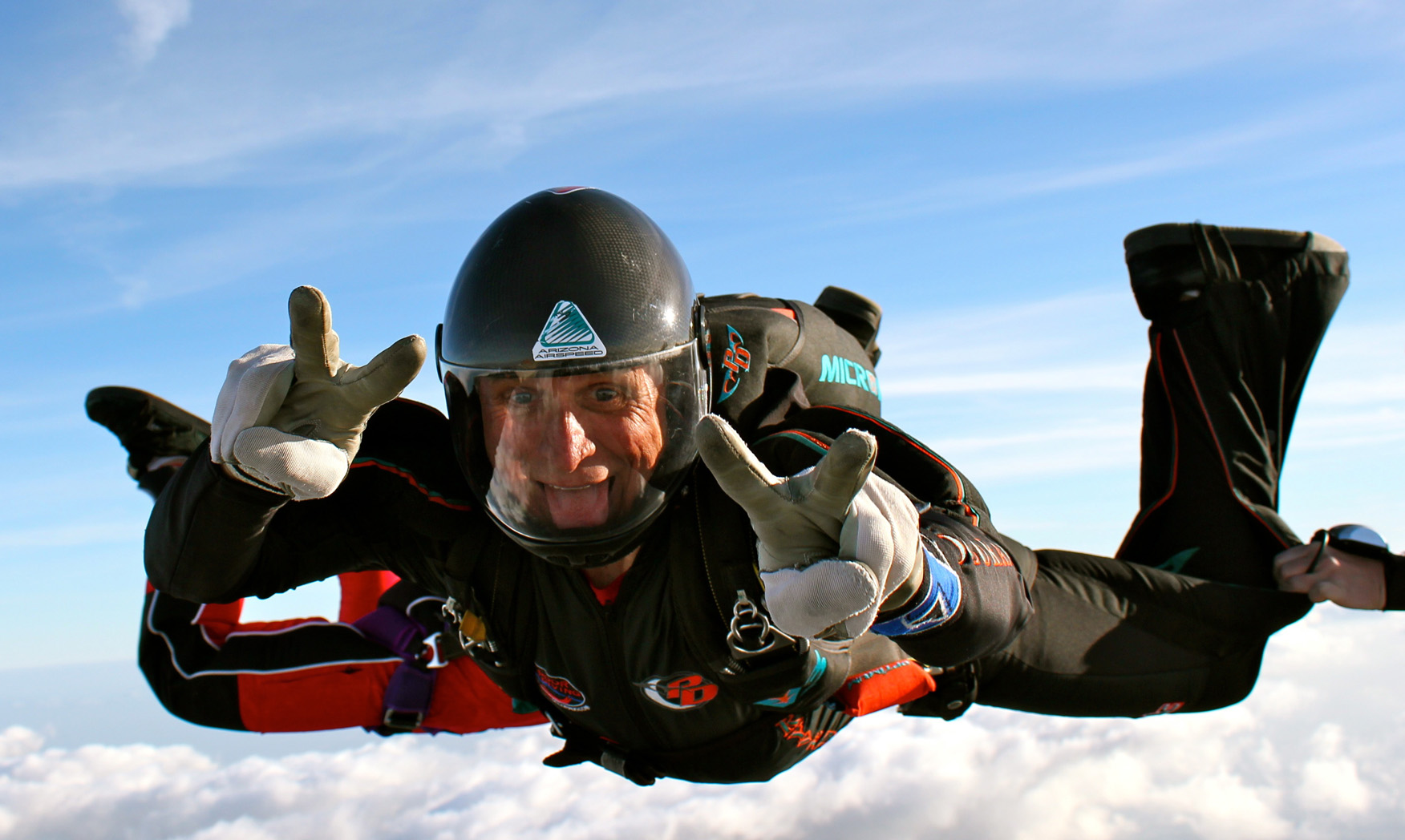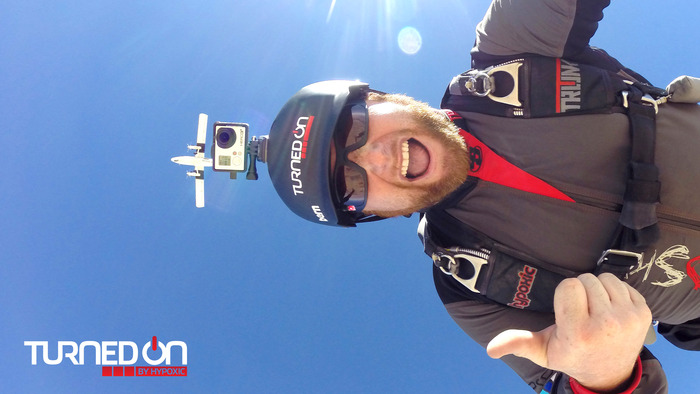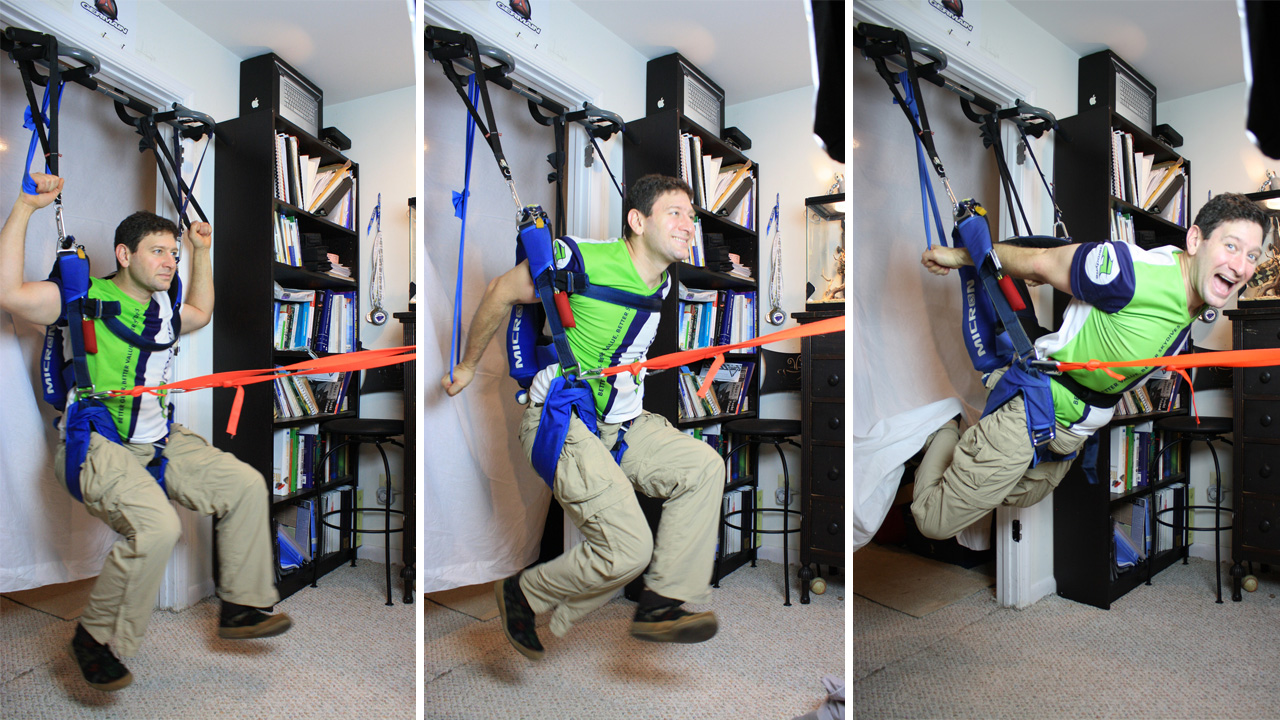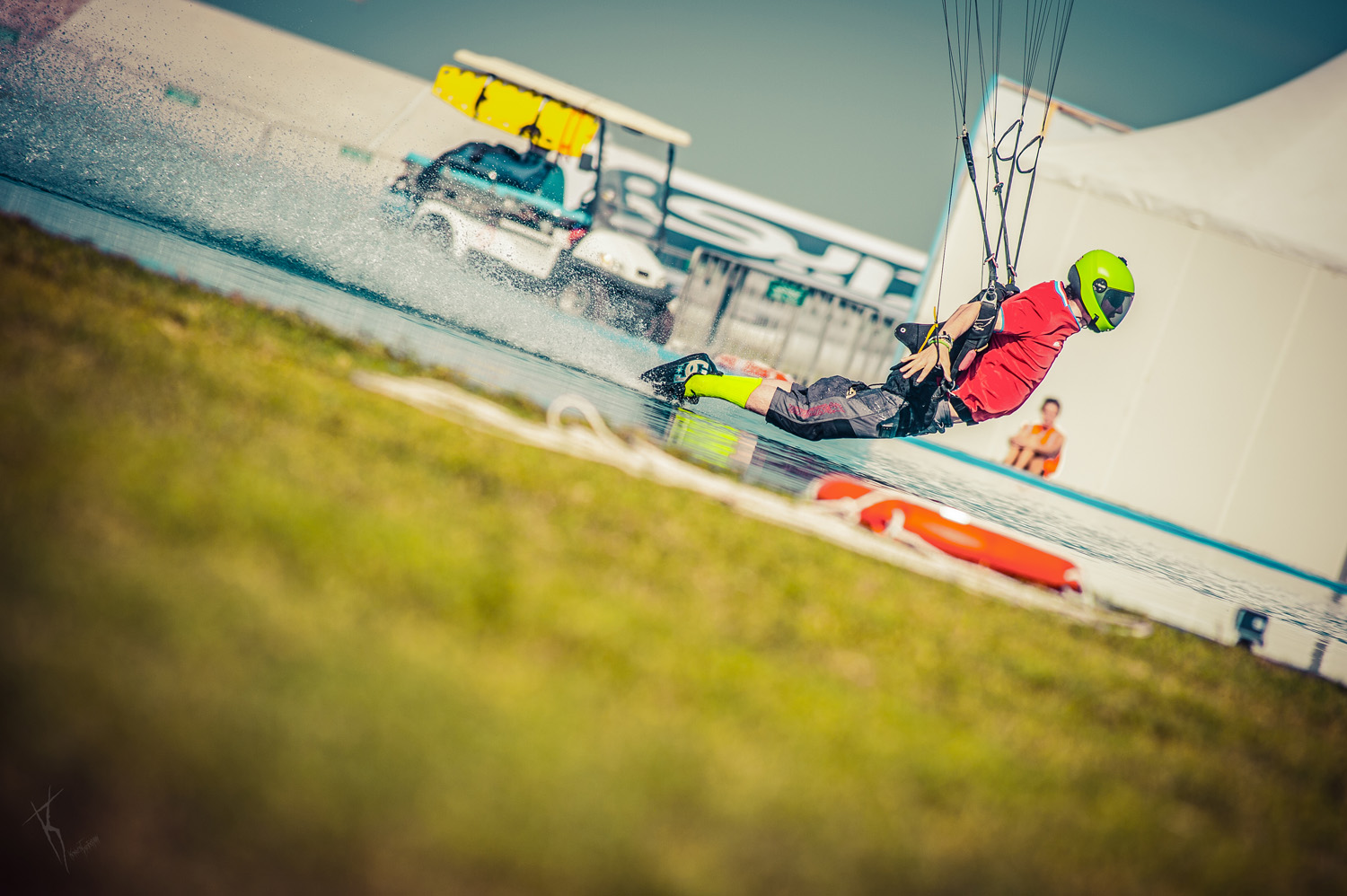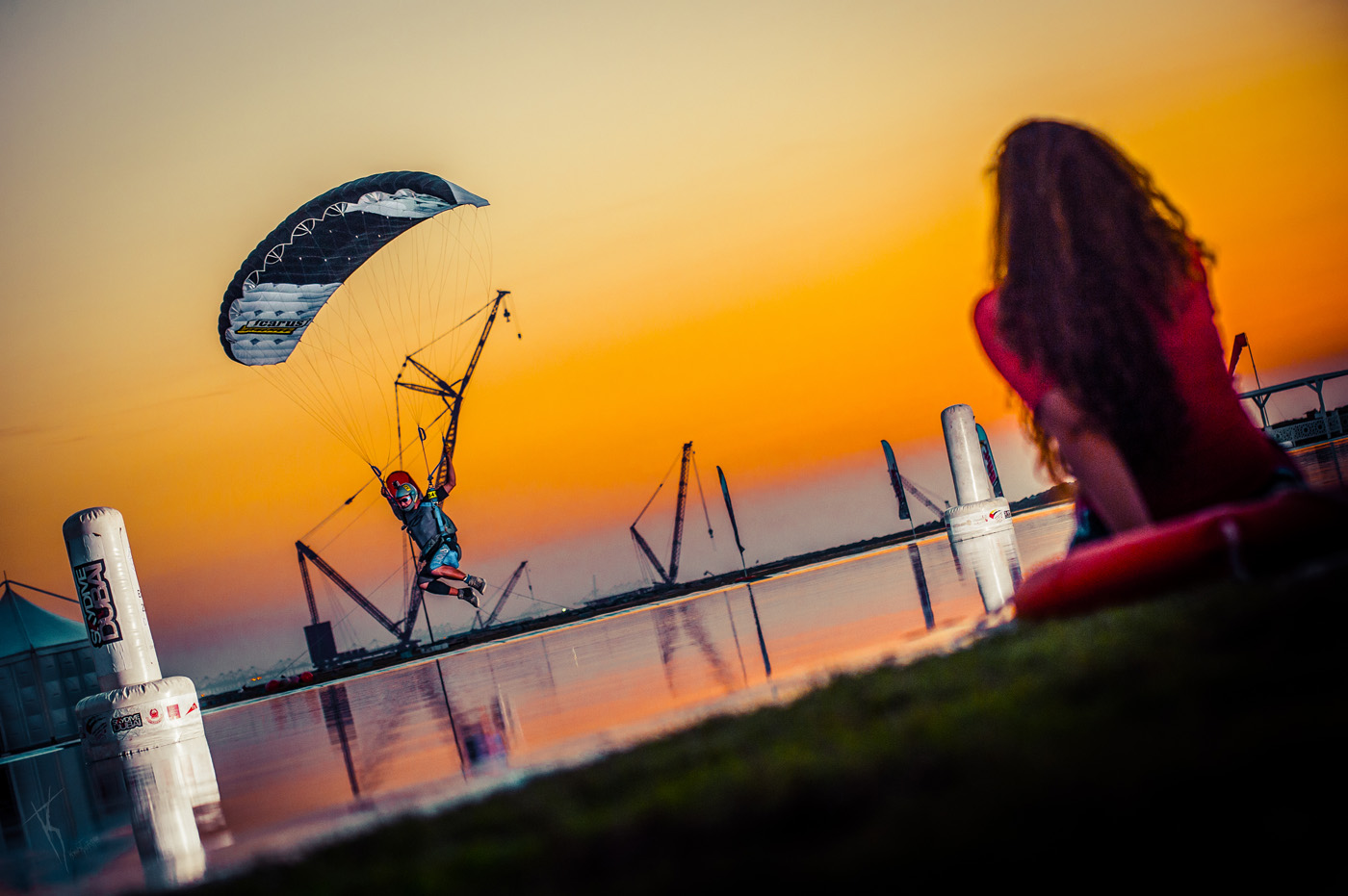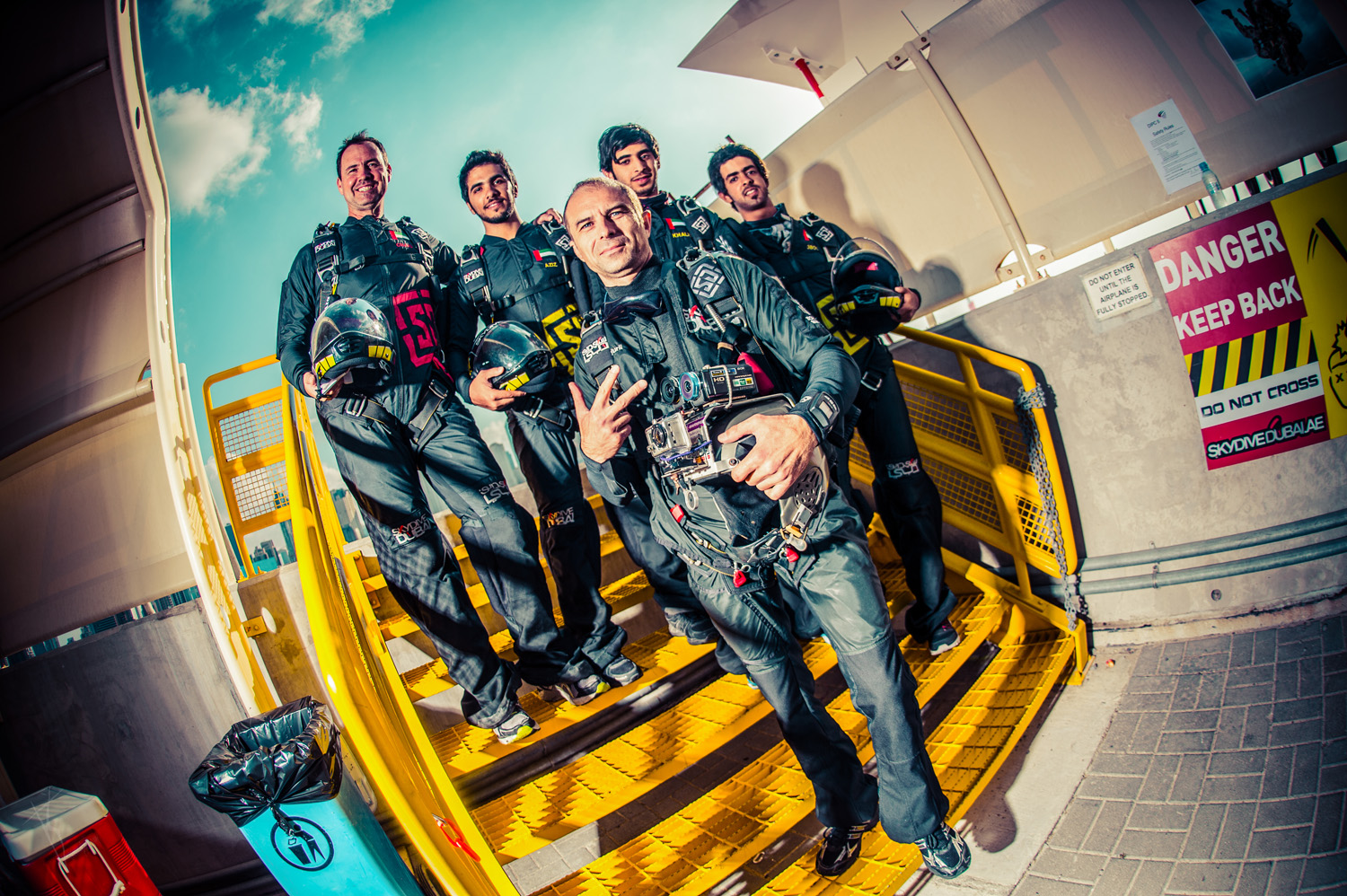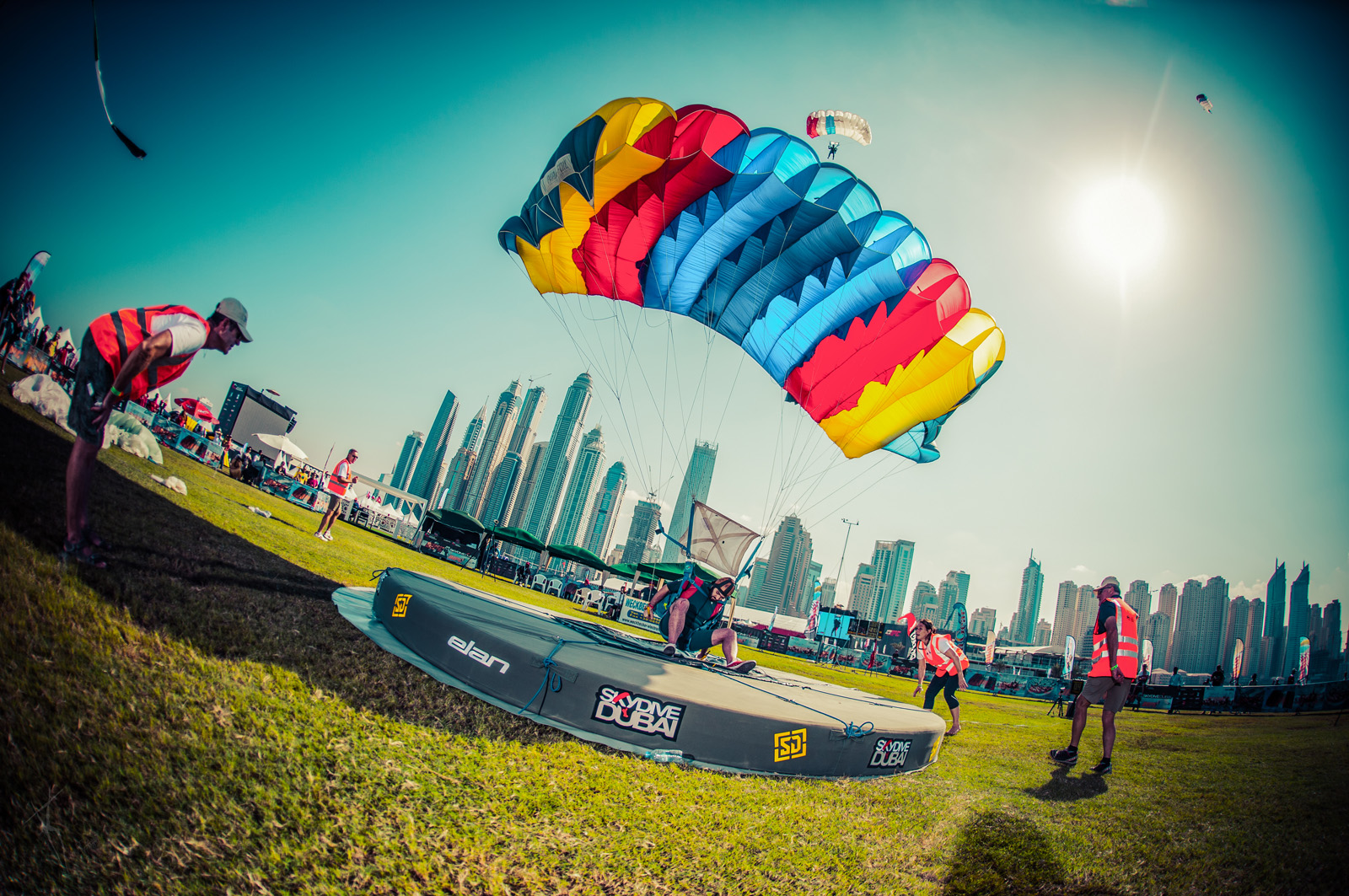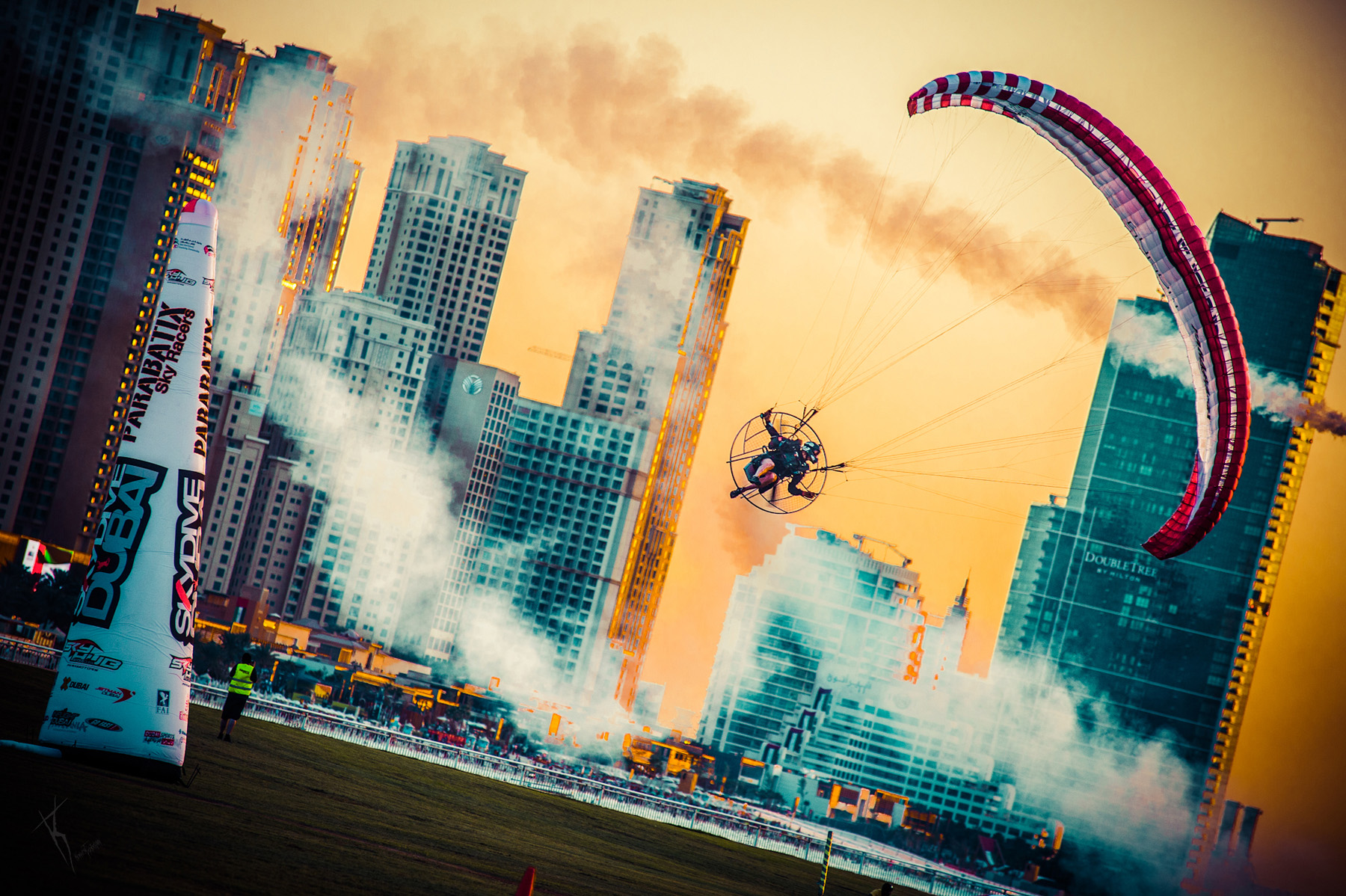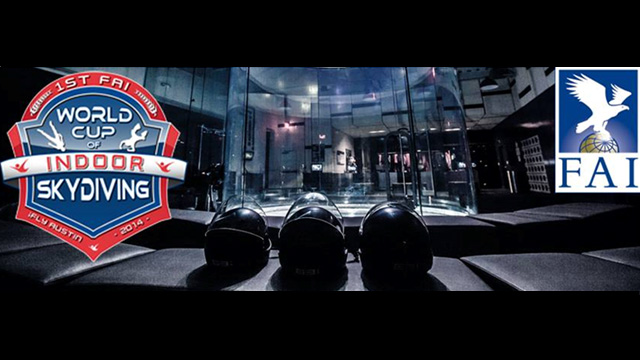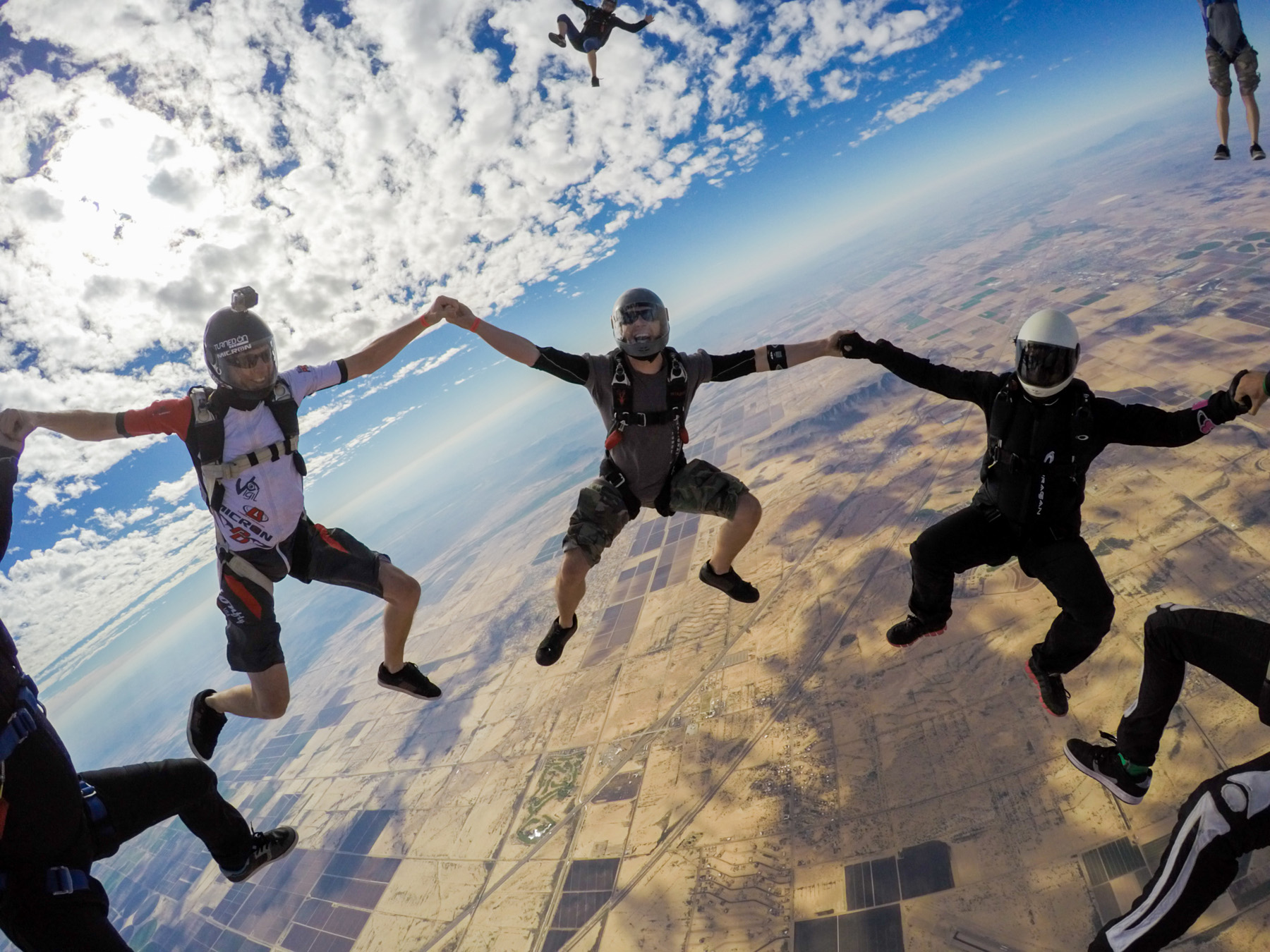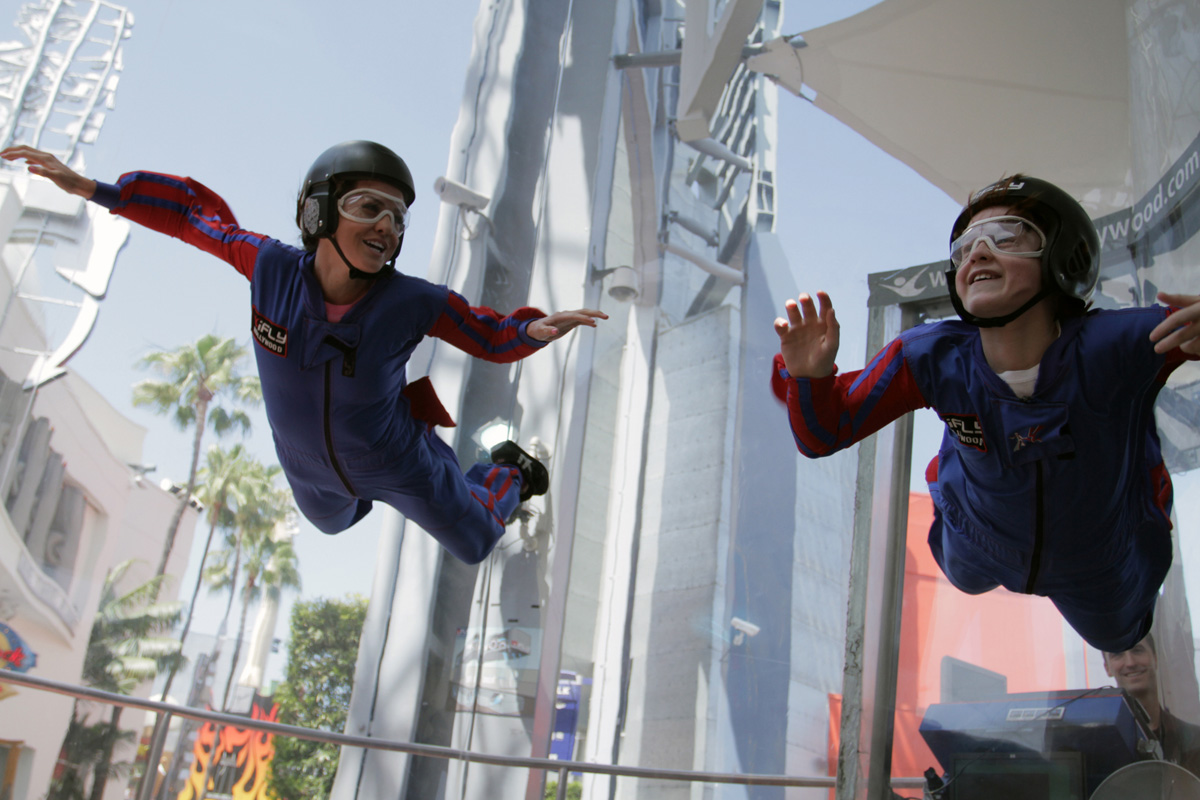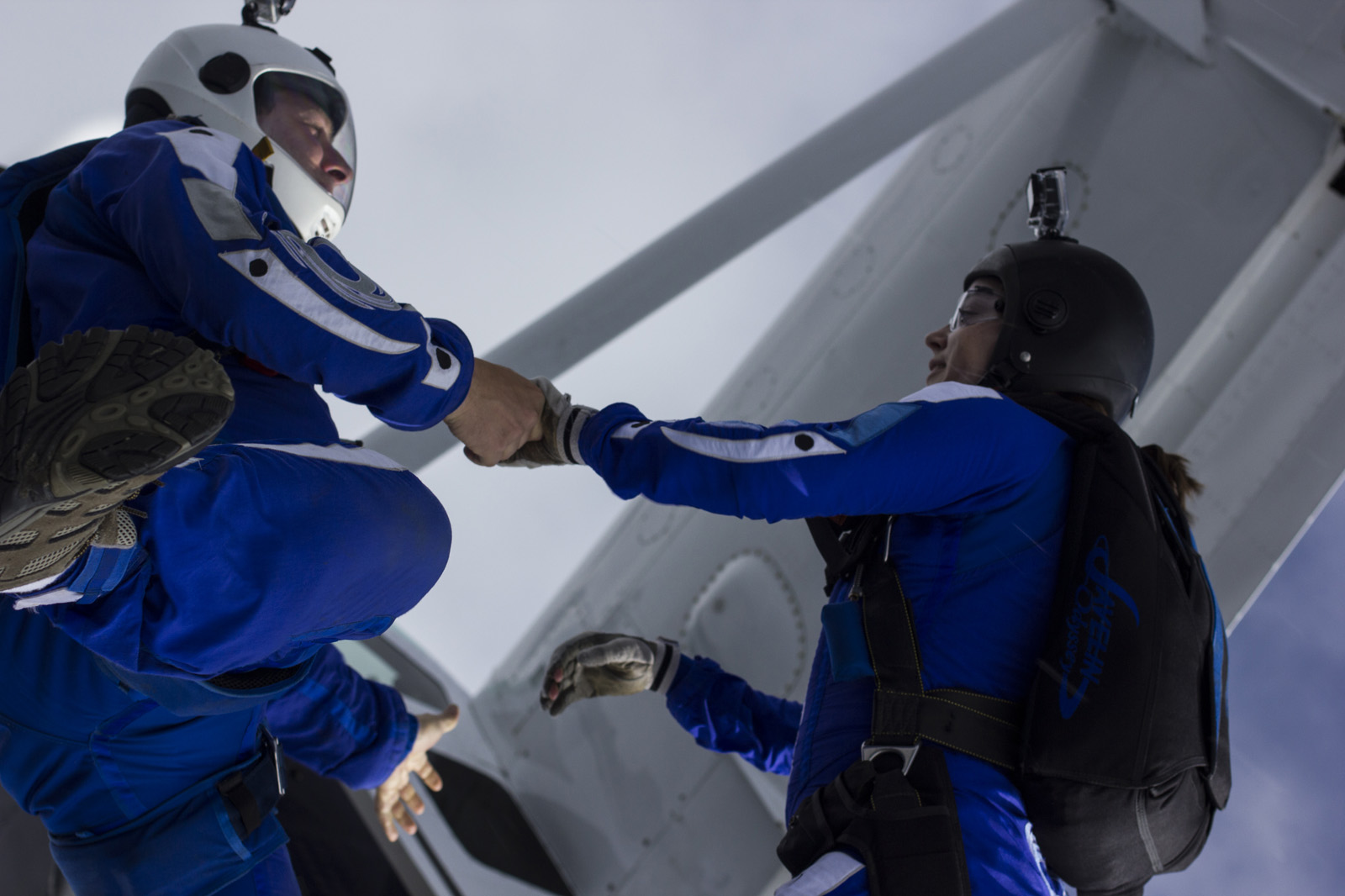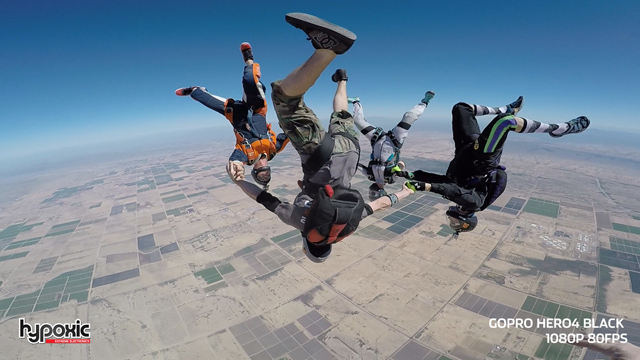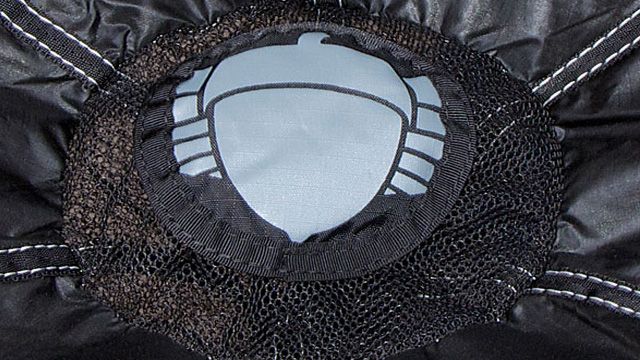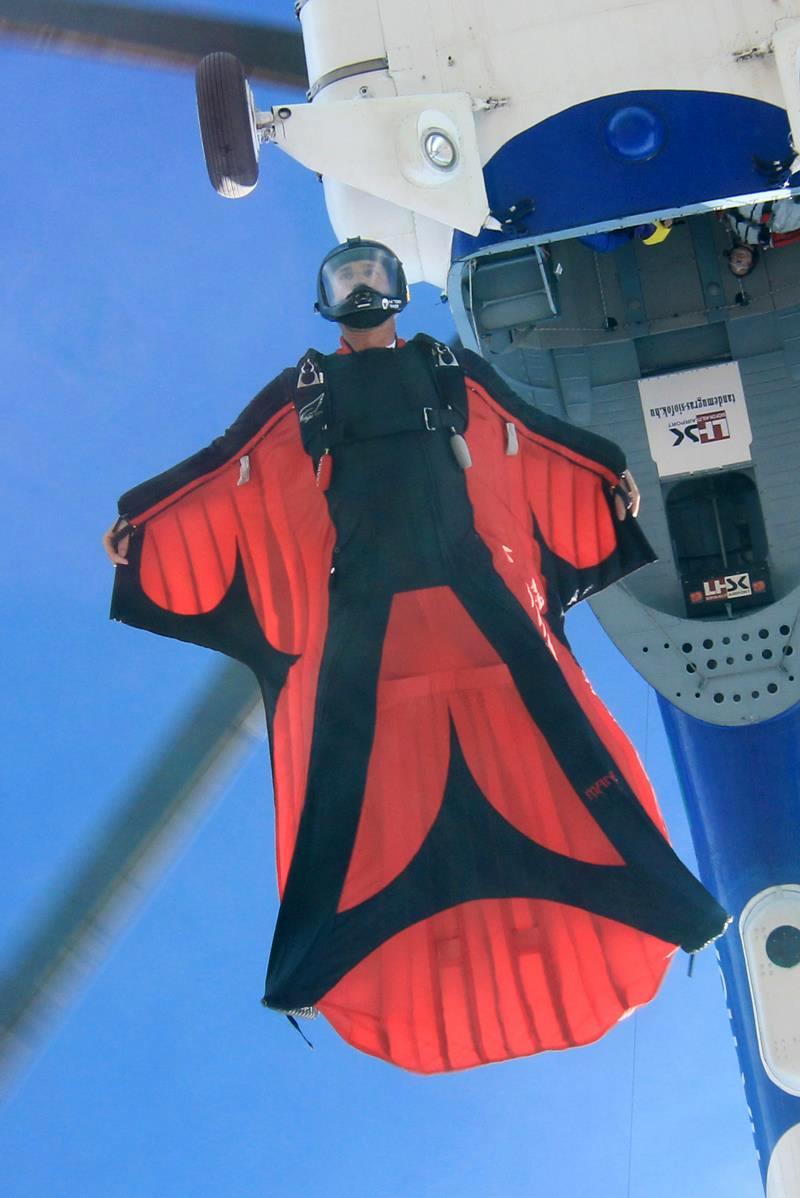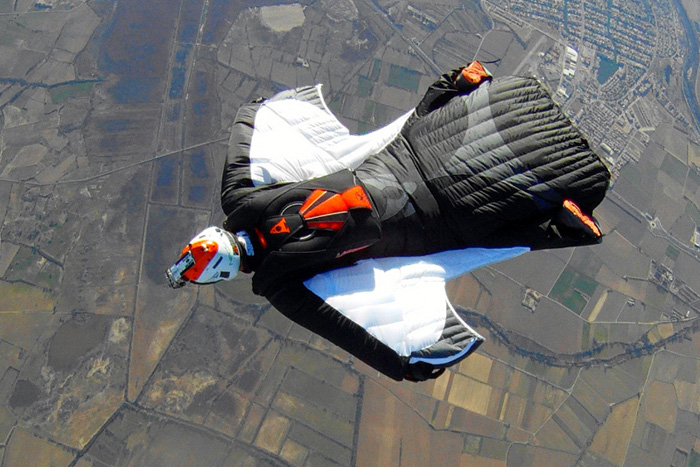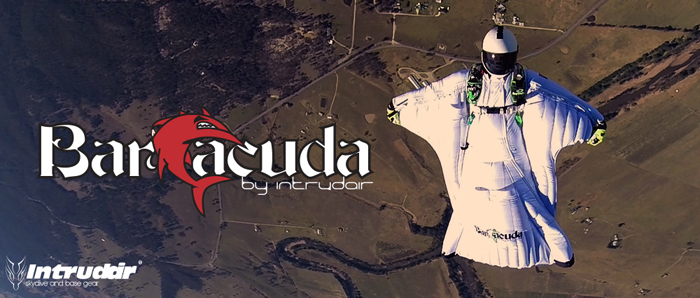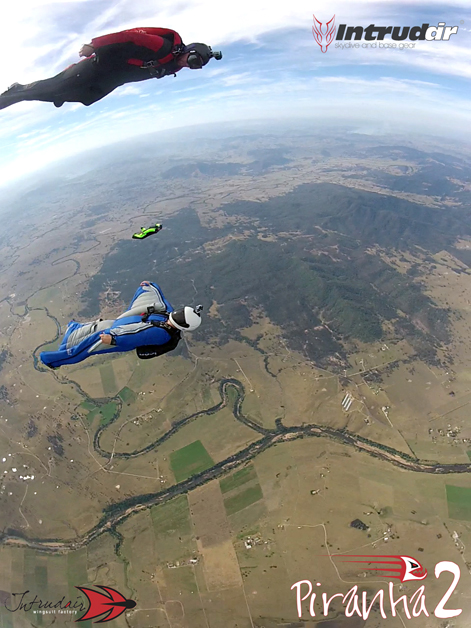-
Content
-14 -
Joined
-
Last visited
-
Days Won
1 -
Feedback
0%
Content Type
Profiles
Forums
Calendar
Dropzones
Gear
Articles
Fatalities
Stolen
Indoor
Help
Downloads
Gallery
Blogs
Store
Videos
Classifieds
Everything posted by admin
-
Image by Ben NelsonNiklas Hemlin of Arizona Airspeed ventured out with a goal in mind and captured his first World Record - but not in belly flying, in the new category, Head Up. Not many long-term and committed belly flyers transition over to freeflying later in their skydiving careers. Especially one that has invested most of their lives into belly flying. It's refreshing to see that the boundaries of belly flying and freeflying are starting to blend. Name: Niklas Hemlin Jumps: 15,500+ (just below 16,000) RW Jumps: 13,000+ Freefly Jumps: 100 ML: How many competitions have you been to? Niklas Hemlin: I have attended 35 national and international recognized competitions. You couple probably double that number if you were to include local and none recognized events. ML: How many medals have you won? Niklas Hemlin: More than 35. ML: Do you have any previous world records, if so, which ones? Niklas Hemlin: I do not have any belly big formation world records J This would be my first big-way world record. I have an un-official world record with Airspeed for the highest 4-way average from when we won the World meet in Dubai 2012 at 27.9 average points. ML: What motivated you as a young jumper and how did you get the idea to tryout to be on Airspeed? Niklas Hemlin: What motivated me as a young jumper was the next jump. I was head-over-heels in love with our sport and the whole nature of it…jumping out of a plane, plunging towards the ground in freefall, pulling your parachute, and safely land to do it all over again. Since then, my love is all the same and more intense than ever. I seem to effortlessly find new ways to keep my passion and intensity for our sport. It has so much to offer me and it is literally limitless. To me, it’s a lifestyle and way of life. ML: What is your new position on Airspeed? Niklas Hemlin: I used to be the inside center and now moved to the point position on Airspeed. Each position on a 4-way team comes with its own style and characteristics. Throughout my 4-way career, I have been floating around all the different slots and found that each offer its own challenges and satisfactions. It is always fun to be put in a situation to learn and refine a new style and to push yourself. To me, it keeps it all fresh and motivating. Performing any slot on a world-class level requires absolute dedication and focus. ML: You're more known in the community to be an RW skydiver, when did you start freeflying? Niklas Hemlin: I seriously started to freefly January 2014. I did do some freeflying back in 1997 here at Skydive Arizona after spending three months in Florida training with my Swedish 4-way team. Since then, I haven’t done any freeflying until I started up in the tunnel this year. I have managed to accumulate about 50 hours in the tunnel YTD and around 100 freefly jumps. I hope to meet my goal of 52 hours of tunnel for this year and 150 jumps. I’m a very goal oriented person and find it hard to keep my competitive spirit at bay. I had a goal of getting to a level in my freeflying that I could go and fly in the tunnel and in the air for fun and hold my own. I remember very vividly seeing people fly in the tunnel and in the air and wanted nothing more than to fly like them, effortlessly float through the air on all angles and on all their body’s flying surfaces. I looked so appealing and fun to me. Airspeed is my heart and soul and takes up a lot of time and dedication. It takes all you time and devotion to become a world champion or a world class flier in any discipline. That being the case, I felt I had to spend the 2014 season to learn freeflying before I transitioned back onto the team as an active member from being an alternate for the 2013 and 2014 seasons. ML: What motivated you to participate in the upright world record? Niklas Hemlin: To put myself in a situation where I HAD to perform. I remember seeing and hearing about the upright record and the headdown big-way scheduled for the fall at Skydive Arizona. I used it as a goal to progress enough to where I could at least participate in the upright warm up weekend. That was enough motivation for me to keep my focus and training. The warm-up weekend went well enough that I was asked to participate in the record attempt. To be honest, I was, and in my opinion still am, not very good on my headup. It is a challenge for me because I really struggle with getting the hang of it and become as comfort and fly as effortlessly as I see others fly. Image by Ben NelsonML: Can you tell me what kind of struggles you had on the record jumps and how you overcame them? Niklas Hemlin: The most overwhelming part of the headup warm-up and record was my visuals. What is left and right headup is right and left headdown. Wow, flying headdown to the formation from exiting head up and then get there to transition back into headup. Oh boy, that was a mind f*#ker (teaser). To be honest, I did not figure than one out until the second day of the record. The second biggest challenge for me was to keep my mind at bay. I was filled with excitement and anxiety and had to calm myself and focus on my basics. Freeflying is not all instinctive and I have to think about what I’m doing and what I need to do. So, if I don’t keep calm and anticipate my flying, it all goes to shit. ML: How much of the Upright World Record principles were like belly fly big ways? Niklas Hemlin: I would say a good 99.9%. That was a huge advantage for me having so much experience with big-ways. That was the easy part. At least I didn’t have to stress out about that. ML: What would be your advice to other belly flyers about getting into freeflying? Niklas Hemlin: Lower your expectations and embrace the whole process of sucking. Do it for fun and understand it is nothing like belly flying, but at the same time, it is just like belly flying. For me, it was very healthy and humbling to “suck” at something again. It was very refreshing to be a student again and having to learn and unlearn. Being the guy in the room with the least amount of experience and, literally, being a safety hazard was a lot of fun for me. Just something about being in the early stages of something new and falling in love with it and not being able to get it out of your head. Oh yea, and it will improve your belly flying tremendously!
-
Sony FDR-X1000VSony have started off the first quarter of 2015 with a couple of action camera announcements that are likely to excite fans of the Sony series. At CES 2015, which was hosted last week, Sony unveiled two new models of action cameras, venturing into the 4k action cam market. Sony are no newcomers to 4k recording products and have been selling 4k recording devices for a few years already, but moving in the direction of smaller and cheaper recording devices such as action cameras is a big step towards general consumers. Along with the new announcement for the 4k action camera, was the announcement of a new HD action camera, a new version of one of the company's popular cameras. The first of the two cameras announced at CES is the FDR-X1000V, the 4k action cam product that will aim to compete with the new GoPro Hero 4. The X1000V will be able to record 4k video (3840x2160) at 30fps, with focus also being placed on enhancements to the HD recording options, stabilization and frame rate. The enhancements in stability come from an upgrade to the company's trademarked "SteadyShot" technology, which is promoted as being 3 times better at handling certain vibrations. With stabilization being such an important part of recording skydiving footage, it will be interesting to see how the X1000V does in comparison to the other Sony action cams on the market. Also beneficial, especially to skydivers - is the new, enhanced wind noise reduction. While the focus of the X1000V definitely appears to be the ability to record in 4K, the camera also boasts some impressive recording abilities at both full HD and standard HD. Up to 120fps is supported for Full HD recording, while Standard HD allows for 240fps recording. Sony HDR-AS200VThe second camera to be announced is the new HDR-AS200V. Last year Sony unveiled the AS100V, which in turn became quite a popular action cam. The AS series of Sony action cameras have in fact probably been the most used Sony product for skydivers, with the releases of the AS15, AS30 and AS100 in just a few short years. We've done extensive testing on some of these models in the past, and they have always performed well, with the Sony AS30 coming out on top in our Action Cam Shootout last year. The AS200V will receive the same boost in stabilization and noise reduction as the above-mentioned X1000V, while offering recording in 60fps at 1080p, 120fps at 720p and 240fps in the WVGA video format. New Features For X1000V and AS200VSony have extended most of the new features they have developed to both of these cameras, and it appears that the only real differences between models will be the ability for 4k recording on the X1000V, as well as a more enhanced underwater casing that is provided with it. Built in GPS & Action Cam Movie Creator Action Cam Movie Creator is software that is included with both the models and allows for the easy creation of videos, which can also use the built-in GPS to display the GPS details in an overlay of the video. Highlight Movie Maker For those who don't want to spend the time creating a movie from a series of clips, the Highlight Movie Maker will offer the ability to quickly and easily produce smaller mp4 video format highlights of a video, along with being able to add music to the video. The Highlight Movie Maker uses an algorithm to detect where the action is happening within the video, and then cuts out scenes which it detects as unimportant. Live View Remote With the new cameras come a new live view LCD remote. The Sony RM-LVR2 is a waterproof (to 3 meters) offers extensive control over both the AS200V and the X1000V, with the ability to control recording, playback, deletion of files. The live view functionality also means that you'll be able to get a clear preview of what is being recorded. Release Dates & Pricing: The X1000V and AS200V will be available from March with the X1000V being priced at $500, packaged with the enhanced SPK-X1 waterproof case. For the live view remote bundle, you will be paying $600. The AS200V will go for $300, and include the SPK-AS2 waterproof case and tripod mount. The live view remote bundle will also cost $100 extra, and set you back $400.
-
Image by CzaplaAs the skydiving market continues to grow and more dropzones open their doors, finding creative ways to make your DZ stand out from the competition is more important than ever. One simple way to gain a competitive advantage is to add lagniappe to your arsenal of marketing tools. What is Lagniappe? (pronounced lan-yap)A Cajun French word often associated with New Orleans, lagniappe is best defined as “a little something extra.” If you've ever checked in at a Hilton DoubleTree Hotel and enjoyed a warm chocolate chip cookie at the front desk, you’ve experienced lagniappe. If you’ve flown Southwest Airlines and checked your bags free of charge, you’ve experienced lagniappe. These “little extras” are not an afterthought, they are an important component of the marketing strategy for companies big and small around the world. Small Business Strategy: LagniappeMy parents run an eco-kayaking tour (Antigua Paddles) on a small Caribbean island. Everyday they compete against 98 other companies for the same cruise ship passengers visiting the island for a few hours. The competitive environment is cutthroat, and my family has needed to use some creativity in order to stand out. Over the past few years, TripAdvisor reviews have become the number one source of marketing for businesses in Antigua. In order to trigger lots of 'talk' on TripAdvisor, my parents have made lagniappe a key component of their marketing strategy and it shows: they are currently ranked number 3 out of 100 attractions on the island. How They Do It - After a fabulous three hour tour combining kayaking, hiking, and snorkeling, guests are offered two unexpected things: a chilled, scented face towel to freshen up and homemade banana bread, baked fresh every morning at 7:00am. Their guests love it. If you take a moment to read some of their TripAdvisor reviews, you'll see just how many people comment on the face towels and banana bread... it's literally like putting the cherry on top of a dessert. How to Use Lagniappe at Your DZHere are a few examples of how you can incorporate lagniappe into your daily operations at the DZ: 1. Free 'ice pops' or freezies. This is an inexpensive gesture that your guests will love while waiting to make their skydives especially during the warm summer months. Kids love this and if you can please impatiently waiting children, parents will love you for it! 2. Complimentary Coffee Mug or Shot Glass - This is a great lagniappe to gift after the skydive. It can be a bit expensive, but there are sources on the web to get some great deals. Check out alibaba.com for the most inexpensive logoed gift ideas. 3. Starbucks Gift Card - If someone leaves a positive review on your Facebook page after their skydive, send them a handwritten thank you note with a free $5 Gift Card to Starbucks or another local coffee shop. If they loved you before, they'll love you even more now! And, added bonus, they’ll probably talk about your unexpected gesture on their social media channels. 4. Discount Fish Bowl - After your guests have made their skydives, have them reach into a fish bowl to draw a ticket for a discount for any merchandise in the store. Discounts range from 5% to 25% off... of course the majority of the tickets will be for 5% off. This is fun for the customer, builds goodwill and it'll encourage guests to think about buying merchandise... everyone loves a deal! 5. Free Reserve Repacks - Reward your licensed skydivers for buying their systems with you instead of going to the big name retailers in the magazines - offer two free reserve repacks when purchasing directly with you. 6. Free Tours for Kids - On a weather hold? Get the kids together and take them to the loft. Allow them to put on a rig, show them the cutaway procedures, teach them where the reserve and main are. As mentioned above, if you can make the kids happy by enhancing their experience, you'll make the parents very happy. The only cost is time. 7. Special Cards - Have your reservations team find out if there are any special occasions with anyone in a group... bachelor parties, birthdays, anniversaries etc. When the individual arrives, surprise them with a special card signed by the staff wishing them a great day in the sky! Executing this is easy - have the staff sign a dozen cards in advance and then have the person taking the reservation, customize it. The recipient will be amazed! 8. Fresh Cookies - This is doable and awesome. Take a page from DoubleTree or Otis Spunkmeyer and offer free cookies to each person after their jump! Good incentive to get people into your store... all you need is a small toaster oven and cookie dough. 9. Personalized Thank You Card for AFF Students - Have AFF instructors fill out personalized cards on a "Jump Well Done" and mail them the same day. Your AFF students will feel encouraged and feel part of the DZ family when they receive their card on Monday. 10. Give Out a Free Beer - Have a bar at your DZ? If so, award your guests with a ticket for a free draft beer or soda. Getting people in the bar after their jump will probably result in some food sales. If you don't have a bar on the DZ, work with a local bar in town...they'd love the extra traffic and your guests will enjoy a cold one at no cost to you!
- 3 comments
-
- industry
- general safety
-
See more
Tagged with:
-
A group of tandem skydivers, as well as a pilot managed to come out alive after a near disaster over Lake Taupo in New Zealand this week. Media sources reported on Wednesday that a group of 6 tandem instructors along with 6 clients were looking to perform jumps at Skydive Taupo, when the aircraft that they were traveling in began to experience problems, forcing them to evacuate. All thirteen individuals, which included the pilot had to leave the aircraft mid-flight while the recognizably pink PAC750 aircraft crashed into Lake Taupo. The plane was reportedly flying at just over 4000 feet at the time of the incident, which is said to have been engine troubles. While 4000 feet is well below the general altitude for a tandem skydive, it was enough altitude to ensure that all the passengers, including the pilot landed safely and that everyone escaped serious injury. A loud noise was heard coming from the engine just seconds after it was evacuated by the pilot, the plane then crashed in the lake below - managing to miss boats and individuals swimming in the lake. Skydive Taupo is a tandem focused dropzone which opened in 2003 and offers customers tandem jumps at 12 000ft or 15 000ft. The pilot who ordered the evacuation of the plane prior to the incident had only recently started working with the company, but is an experienced pilot. Skydive Taupo has since posted a message on Facebook giving thanking people for support and giving props to those involved on their handling of the situation. Post by Skydive Taupo.
-
SKYDIVE LIVE’s Annual JUMP INTO THE NEW YEAR Boogie 16-19 January 2015 Our PAC750 airplane, friends, raffles, good vibes and lots of jumping in celebration of the New Year! Come on down Thursday night, January 15th, and hangout with us as we prepare for this fun-filled FOUR day weekend event. We have the fastest jump plane in the Florida panhandle - a PAC750 starting up at 9am on Friday, and a Cessna 182 for hop n’ pops. The DZ is 20 acres with 200+ acres of safe “outs” and plenty of space for you to camp out – either pitch a tent or sleep in our 5,000 square foot hangar which is carpeted for packing and is equipped with an personal outdoor shower available for use. RV hookups are available for a small fee and families are always welcome – bounce house and toys for the kids. There will be lots to do each day, weather days we’ll have free courses, camera course, safety and exit order courses, and anything else you request, just give hit us up on our Facebook page, Skydive Live, and ask. The "GoPro pic of the day" gets a free jump, we'll have Last Load of the day Swoop n’ Chugs, load organizers – from belly to free fly, bonfires at night, and more to follow! For the $25 entry fee, you get a free t-shirt, free lunch each day, and one ticket toward any of the raffles. Friday is a Pig Pick’n BBQ. We ask that everyone please bring a side dish. Saturday night, will be catered – Chicken n’ Dumplings, sweet potato casserole, green beans and more, all for $10. Breakfast is available – you can skydive for 4 days straight cause everything from the time you wake up to the time you go to bed is taken care of! No need wasting time running in to town– just have fun! Raffles – 20 minutes in the Paraclete XP tunnel in North Carolina, a free reserve pack job, a full or open face helmet, your choice and more to come. There will be organizers for all levels of FS and Free Fly, several coaches, and riggers on staff. Two Awesome free fly coaches – Matt and Darcy, Darcy will be our FreeFly Load Organizer. Our full time packer is Jerrid – He’ll pack, you just jump! Sandy Grillet will be making an appearance as our load organizer for the weekend. Sandy is a current 4, 8, and 16 way competitor with over 9,600 jumps. He’s as much a coach as he is a load organizer so if you’re looking to improve your belly skills, Sandy is your guy! Julia Secker-Walker is an AFF-I, coach, and videographer with 700+ jumps. She enjoys skydiving in all disciplines and she especially likes jumping with new students! We are excited to have Julia on staff this season! So whether it’s your 5th jump or 5,000th jump come out to Skydive Live @ 5138 County Highway 0605 Defuniak Springs, FL. 32433 (some GPS’s have the Highway 0605 as Jackson Still Cutoff, they are the same) Schedule training/tandems with Dave 910-533-9097 Any DZ questions, call Jim 850-978-4532. Questions or directions, see www.skydivelive.com Looking forward to a great weekend!
-
In May of 2014 the skydiving-focused electronics company Hypoxic began a Kickstarter campaign that sought out a goal funding of $30,000 in order to develop a status indicator for the GoPro action camera. Despite dominating the market for several years, neither GoPro or its primary competitors come with a feature or piece of hardware that allows the user to easily determine the status of the camera or its recording. For sports where the GoPro is mounted out of sight, such as the popular helmet mounting method, this can often cause hesitation when trying to remember whether you may have pressed record or whether you put the SD card back. Hypoxic's goal was to try and provide a useful and easy way of determining whether the camera is functioning as it should, while also removing that hesitation from the minds of the jumper. As quoted from the Kickstarter page: "In our sports, these uncertainties are not just unsettling: they’re dangerous. As an athlete, you know: before riding down this line, starting this race, jumping out of this plane, launching down this mountain, you need an absolutely clear head. Nothing good can happen when personal safety takes a backseat to a blinking light." By the end of June last year, the Kickstarter campaign had raised $43,049, more than $13,000 over the original target amount. Incentives for backers ranged from stickers for those that pledged $5 or more, to Turned On units with early shipping for backers that pledged over $180. Over the past 6 months the Kickstarter units have been sent to the backers of the campaign and were well received. The Turned On units have now begun shipping to outlets and are available for public purchase. What Does It Do?The Turned On unit makes use of 3 colored LED lights to provide information as to the status of the camera. When the camera is recording, the light will be solid red. When it is on standby a blue light will be displayed. When an error is present it will display either a solid yellow or a flashing yellow light. When the light is flashing yellow, it indicates a potential impending interruption to recording, such as low card space, low battery or high temperature. A solid yellow light indicates an error and in this case, the camera will not be able to record, such as in situations where the card is missing or corrupt. The device will work in all modes, and show the active recording light whether you're recording video or shooting a series of images in burst mode. What separates the Turned On indicator from other indicators on the market is the detailed level of information provided. Most other indicators simply use an on/off system that will display whether or not the camera is recording or even just whether the power is on, which is often unreliable - especially in cases when the camera may be in stand by mode. Compatibility and SupportCurrently there is limited compatibility with the Turned On, and will require one of the following GoPro cameras: GoPro Hero 4 Black, GoPro Hero 4 Silver, GoPro Hero 3+ Black, GoPro Hero 3 Black. Supported Versions GoPro Hero 4 Black - v1.02.00 GoPro Hero 4 Silver - v1.0.2.00 GoPro Hero 3+ Black - v1.04.00 GoPro Hero 3 Black - v3.00.00 There are two build of the Turned On available, the H3+/H4 and the H3. The H3+/H4 is designed for use with the GoPro Hero 3+ and GoPro Hero 4 cases, while the H3 model is for use with the GoPro Hero 3 case. Hypoxic are already looking to expand the development to include more of the GoPro models and claim to be exploring compatibility that goes back to the GoPro Hero 2. Where to Get One?Dealers that are listed with selling the Turned On units are as follows: Chuting Star - Skydive the Farm, GA Patrick Kaye - Skydive Dubai, Dubai, UAE Para-Gear - Skokie, IL Ranch Pro Shop / Tonfly USA - Skydive the Ranch, NY The Drop Shop - Skydive Chicago Gold Coast Skydivers - Gold Coast Skydivers, LA Sunshine Factory - ZHills, FL Rock Sky Market - Chicago Skydive Center, IL Xtreme Video - Skydive Carolina, Chester, SC HYPOXIC - Chandler, AZ As of the release of this article, the MSRP for the Turned On units was listed as $99. More information and installation guides can be found on the Turned On Website.
-
The winter months are a great opportunity to catch up on all the things we weren’t doing throughout the summer, such as working on our homes, engaging in winter sports, and mending relationships with our non-skydiving friends. It is also a time that can lead to a dulling of our skydiving abilities, and our memory of correct procedures. As a result, the period following a substantial break can be a very dangerous time for skydivers, and a great many injuries come as a direct result of a lack of currency. If we are creative, however, we can keep our skydiving minds warm even when it is cold outside. If you own a rig, for instance, it is quite easy to set up a hanging harness in your house. We have been using a secure chin-up bar for many years, and it works great. All you need is an extra pair of risers, a set of soft links, two climbing carabiners and a doorway. A retired pair of 18 inch risers work best for most doorways, to keep you high enough above the ground to create a good simulation. First, attach the tops of the spare set of risers together with the soft links. Next, loop the risers over the chin-up bar, and attach a carabiner to the large ring on the bottom of the risers. Then all you need to do is clip the carabiners through the three ring attachment hardware on your rig and you are ready to train. Keep in mind that if you are unsure about the security of your chin-up bar or door frame structure, be sure to wear a helmet and have a cushion underneath you just in case things go badly. Some of you are thinking, I don’t need to practice pulling my handles all winter, I am a licensed skydiver. I know what I’m doing. Although we all know this is not the truth, everyone needs to practice their emergency procedures, the point of hanging yourself up goes far deeper than just practicing pulling your handles. There are a great many things you can rehearse and learn while suspended in your own rig. I am not talking about the tired old harness at the dropzone that does not remotely resemble the one you jump. I am embarrassed for our sport when I do not even find one of these old beaters hanging at a training facility. That needs to change. No, I am talking about your own personal rig: your handles, your harness, your home. There are several things you will love about this initially embarrassing practice. One huge benefit is to practice transitioning from your deployment harness configuration to the flying and landing configuration. For most of us, this involves loosening the chest strap, and experimenting with different methods of moving the leg straps slightly forward to make yourself more comfortable. By sitting in the harness for long periods of time, your body can change and become stronger in the ways that allow you to be more comfortable under canopy. You can also explore harness turn inputs by swinging side to side by loading one legstrap at a time, which may illuminate a need to relocate the elastic butt strap between your legstraps. This “freefly bungee” is great for preventing a legstrap from sliding forward in freefall, but if located too high or too short, can prevent harness turn capability while under canopy. A “fastex” pinch-release can allow you to remove this strap entirely, and hanging harness training can prepare you for the new muscle memory of your procedural change. Hanging harness training will also allow you to practice flaring and leaning forward for landing. You can even tie webbing straps to the legstrap articulation hardware and have a friend pull your legs forward when you flare to simulate the pitch change, allowing you to rehearse leaning forward as the canopy pitches back to a higher angle of attack. This will help you to remain in balance for the touchdown, and by rehearsing this process in your downtime, you may even emerge from the ice and snow with more skill than the previous summer. Further, you can maintain your upper body strength in the canopy-specific muscles by lifting yourself up by the front risers dive loops, and by pulling on elastic bungee cords or “thera-bands” attached to the chin-up bar. These are easily acquired from most physical therapists, drug stores or apothecaries. By using carabiners to attach yourself to the suspension system, you will be able to avoid the need to remove your main parachute for the simulation. It will feel slightly different with your main parachute still in the pack tray, but it will be close enough to make the practice a valid training method for staying fresh through the chilly months. It is also helpful to remove your main from time to time, and attach the suspended risers to your rig’s three ring system to practice cutting away. A mattress, helmet and spotter is a really good idea for this practice. This will help you to get a clearer picture of what it actually feels like to chop your main, and may even result in your awakening to the fact that your method of pulling the handles needs work, or that your cutaway system requires lubrication. Be sure not to actually pull your reserve ripcord unless you have a rigger handy. When you do bring it in for your spring repack, definitely give that reserve ripcord a go in a full simulation. All good training requires accurate, complete rehearsal of what you will need to do in the sky. For wingsuit flyers, a hanging harness can be a fantastic training tool for staying current with the post-deployment sequence. Gear up fully and practice riding through the deployment with your knees together and your hands on the three rings. Then rehearse unzipping your arms, unstowing the toggles, loosening the chest strap and then unzipping and dressing your legs. For increased realism, try aiming a carpet blower up at you at the approximate glide angle of the canopy to simulate the relative wind. This will add the pressurization of the wings, making the process surprisingly like the real thing. If you wear your helmet as you do all of this, the simulation will be quite realistic and highly beneficial. Such rehearsal will be very helpful for keeping the habits that save your life fresh in your mind. Be sure to practice malfunction procedures with your wingsuit on as well. The only thing you need to worry about is the doorbell, and the awkward explanation to the mailman. Freefall skills are harder to keep fresh, unless you have a wind tunnel nearby. There are ways, however, to keep sharp without spending a lot of money. An FS “creeper” is a fantastic tool for practicing your belly flying, and creeper parties are a fun way to get jumpers together in the colder months. You can even have creeper competitions to stay on your game. It may feel a bit silly at times, but it is far better than trying to remember the dive pools all over again when the snow melts. I also find that an indoor swimming pool is a great asset in the winter, allowing you to work in three dimensions and play with new possibilities, especially if you have fun-loving skydiver friends. Nose plugs are really helpful for upside down swimming. I also enjoy pulling out my gear in the winter and taking the time to slowly and methodically look over all the details I may not have had the time to check during the fast-paced summer months. Even if you are not a certified rigger, this is your gear and you need to be comfortable with every aspect of the equipment that saves your life. Pull out your main and climb inside your cells; inspecting the crossports, the seams, and the reinforcing tapes. Look for broken stitches, pulls, and damage to the fabric that may have occurred during the jumping season. Inspect the bottom of your lines, your connector links and risers. Be sure to run your finger inside the slider grommets to check for rough spots that will damage your lines. You can also check your line trim by cutting the main away and tying the risers to something secure like a door hinge. By pulling tension on each line group in bilateral symmetry and comparing back to the center cell, you will learn volumes about the condition of your parachute. If you have spectra lines, you will be amazed how much your outboard lines and brakes will shrink over time through friction against the slider grommets, and from lack of loading. For a detailed education on main parachute inspection and an eye-opening retrimming technique, check out this video. Another powerful way to keep your head in the skydiving game is through watching videos. There is a great deal of eye candy on the internet, although not all of it falls under the category of training, or even positive visualization. Be careful what you watch, visualization is a powerful form of training, and some of what you watch can pave the way to higher levels of fear. Furthermore, watching lots of poor technique can dull your image of the “right” way to fly. Fortunately, there are some fantastic instructional videos available, which can actually expand your skydiving knowledge as the snow falls. The Australian Parachute Federation, for instance, created a fantastic malfunction video series called Cutaway. Additionally, here is a link to an in-depth Parachute Flight Safety Video Series, a canopy course ground school for all levels that will far exceed your expectations. To further the goal of expanding your skydiving skill through knowledge, there are also several incredible podcasts on the internet that can bring a wealth of knowledge to your computer, phone or tablet. Skydive Radio, Jump Twenty Six and Radio Skydive UK all provide a wealth of information that can enhance your abilities and literally extend your life. Interviews with leaders in the sport will expand your knowledge of the essential history of skydiving, safety practices, and secrets to get the most out of your airtime. Best of all, you can enjoy this learning in the comfort of your own earplugs. When we remember that most of what it means to be a skydiver actually happens on the ground, it becomes more than obvious that we do not need to turn off our skydiving brains once the chill hits the air. Although it is true that a flight to someplace warm is the best way to stay current in the winter, it is not the only way to continue being a skydiver. With a bit of open-minded creativity and ingenuity, we can continue our training all year long, and even emerge in the springtime with a deeper understanding than we had before. Freezing our thoughts about something we love this much not only increases our risks, it also costs us a piece of ourselves. Pull out your gear and keep the feeling alive, you will be glad you did. -BSG Brian Germain is a parachute designer, author, radio personality, keynote speaker, and has been an active skydiver for 30 years. You can get more of Brian’s teaching at Adventure Wisdom, Big Air Sportz, Transcending Fear, and on his vast YouTube Channel
-
All Imagery By Konwent Photography After completing 3 rounds of Zone Accuracy, 2 rounds of Speed-Distance, 2 rounds of Distance and 2 rounds of Speed - all swoopers were ready to relax. Out of 59 CP competitors only 22 decided to take part in Freestyle competition on the very last day of 5th DIPC in Dubai. In one of the previous bulletins an important change was announced. Last year every competitor could decide for himself to participate in CP Freestyle or not. This year only the first 30 competitors of overall were supposed to be allowed to compete. “Supposed to” - because apparently this limitation has been cancelled 1h before the first round when only 10 approved competitors showed up. That’s why all CP competitors were finally allowed to compete. All day long were able to watch 22 swoopers doing NacNacs, Kowboys, Flips, Lazy Boys, Supermen and many other tricks. We’ve also asked Bjoern Korth, Event Judge of Canopy Piloting about the reason of new limitations. “The majority of swoopers focus on Distance, Speed and Accuracy in their training. For safety reasons we didn’t want to allow all swoopers to participate." - “The majority of swoopers focus on Distance, Speed and Accuracy in their training. For safety reasons we didn’t want to allow all swoopers to participate. Some of them might never done freestyle before. Competition is not the best place to start.” - says Bjoern - “Freestyle is also difficult to judge, it was not judged often before. Of course we have guidelines from FAI, but it’s still something new.” But looking at those who took part in these additional 3 rounds, they all seem to be happy about the jumps they’ve made. Even if not swooped perfectly, they were doing some really cool stuff with the pond just as it was their playground. We all hope that next year more competitors will take part in this spectacular show. - Well, I think that people don’t want to get hurt on the last day of the competition. Many of them leave Dubai tomorrow and the wet rig weights way more - laughs Marat Leiras from Skydive Dubai Team - Freestyle is great, lots of fun, everybody is relaxed and can explore this beautiful swoop pond. I try to use my imagination, free my mind and soul. During World Air Games 2013 organizers tried to combine Freestyle with “regular” Distance, Speed and Accuracy and it was really great. Something fresh and new in the sport. The last day of 5th DIPCBelieve it or not, but during CP Freestyle the audience was much more active and numerous than during any other swooping discipline. Hundreds of people were giving big applause for every trick that ended up in the water and even bigger for spectacular maneuvers finished smoothly on the ground. - It’s really cool, I hope that next year I will be able to watch it again! It’s a new style of swooping, exciting and probably very dangerous - says Lydia watching the show. - I had to decide between Accuracy landings on the Beach DZ and Freestyle Swooping here - says a man with a Kazahstan T-shirt - but it was worth staying close to the swoop pond. As the CP Freestyle rules are difficult to follow for most of the audience, Regan Tetlow (Media Presenter of DIPC) and Greg Windmiller (USA National Team) explained every trick and the guidelines that competitors should follow. But not only the trick itself matters. Judges asses everything: setup, trick accuracy, landing and how long the trick was held on the pond. Final results are impacted by all those factors. - DIPC is doing great job for parachuting and skydiving in general. They really try to keep CP close to the public. Everything is organized so great, that it could be a kind of “benchmark” for all other parachuting event organizers - says Greg Windmiller. Bye bye, Dubai2014 DIPC took 8 long days. The variety of all skydiving disciplines, colorful surroundings, airshows, extreme sport itself - made the event great for professional and amateur photographers. HIPA organized the contest holding one of the highest money prize in the world ($7000 for 1st place, $25000 in all awards). - "It’s a great event for us, photographers" - Juan Mayer, Skydive Dubai photographer - "I don’t have many chances to see the Jumeirah Palm from other angles than usual, but when jumping on the Beach DZ I could really rediscover its beauty." The submission is already closed so we all look forward to see the results. Just before the Closing Ceremony a 50-way formation was jumped. Skydivers created “43” number to celebrate 43rd National Day of UAE. After spectacular airshows of Al Fursan, Zoltan Team and Parabatix - all medals have been given to the heros of the event. France, Russia and USA (and other) anthems were played many times during this evening. And this is how 5th DIPC became history. Current results can be found at both Omniskore's and EAF's websites Marta Molińska is a 28 year old skydiver, event organizer, PR specialist, journalist. She currently lives in Poland, running social media and event management for her domestic Dropzone Sky Camp. She fell in love with skydiving 2 years ago, and has over 600 jumps. She smiles a lot (like it was her trade mark).
-
All Imagery By Konwent Photography The first day of CP in Dubai was supposed to take place on Tuesday, 2nd Dec on the Independence Day in Dubai. Unfortunately strong winds put both Accuracy and Canopy Piloting on hold. From canopy disciplines only CF was actually flying. The busy dropzone was focused more on perfomers, airshows and holiday celebration. First swoops were made on Wednesday morning. - "The conditions change between rounds but in the first round I was able to make good adjustements and scored 100" - says Curt Bartholomew from Alter Ego Team after first round of Accuracy - "Of course I prefer to go headwind, this is how it was today, but everything depends on location specifics and here Accuracy goes always in the same direction. Sometimes it’s downwind, sometimes headwind. The factor we cannot influence." - "I’m happy with the results so far" - Cornelia Mihai from Skydive Dubai Team with a big smile leaving the swoop pond - "We’ll see how it goes with next rounds." "The truth is that even the slightest change of wind speed or direction can make a huge difference in the results. It’s not rare for comeptitors to have more than one canopy of the same model (like Petra or Peregrine) but in different sizes to make a choice just before the jump accordingly to weather conditions. - In practice round I took Peregrine 75, but for the first round I flew Peregrine 67." - adds Curt. The pilot is a real engine of his canopyThe choice of the canopy seems to be one of the CP aspects which may determine a career. To make it simpler, there are two manufacturers that provide swoopers with high performing canopies: Performance Designs and NZ Aerosport. They delivered to the market, the Peregrine and Petra, which are already used by the majority of competitors. As none of them are useful for everyday freefall jumping, users needed a canopy with performance of Peregrine/Petra and terminal deployment tolerance. (NZ Aerosports have, since publication told us that the Petra is able to open in terminal and opens well with a normal slider and RDS) So more than 1 year ago Leia form NZ Aerosport was announced to be ready to sell and just two weeks ago PD released trailer of Valkyrie. Both canopies are described as high performing with smooth openings and being perfectly good for freefall jumping. "If you take basic aerodynamics, this is the logical direction to go." - John LeBlanc - "If you take basic aerodynamics, this is the logical direction to go." - John LeBlanc, PD vice-president and head of R&D; - "But I must admit that the Valkyrie project started before the Peregrine development. We have 40-120 prototypes every year and we only announce the new product to be ready when it’s really great." - "It’s a step up from Velocity or Comp Velocity. It was designed to be an everyday usage canopy with higher performance." - says Albert Berchtold, marketing representative of PD - "It’s a different canopy than Leia, even if some claims otherwise. We were working on it at the same time as NZ for a couple of years now and we’re really happy with what Valkyrie became. Just ask users if they like it!" And we actually did. Pablo Hernandez, winner of DISL (Swoop League) says: "The first thing that comes to me when I think of Valkyrie is the amazing openings. Really smooth and soft, my neck and back loved it from the frist jump. It also has a lot of rear risers power and toggles power. It can be used as an everyday canopy but it’s good for competition as well, mostly for Accuracy. I don’t jump it here, as I only have 30-40 jumps on it but for the next competition I will probably take it." The first users’ descriptions of Valkyrie performance seem to be similar to Leia characteristics. - "We arrived at the Leia trying to find Petras little sister as it were" - says Richard Munro from NZ Aerosport - "A high performance wing that incorporates many design elements of Petra without some of the practical limiatations. It’s probably reasonable to think PD had similar intent with their canopy development. In the end, the competition between the manufactuers only leads to better canopies - the pilots are the real winners." - "I really love Leia, it’s good for Accuracy jumping in competitions but I would say it’s more dedicated to everyday skydives" - claims Lee Barraclough, competitor from NZ Aerosport - "The openings are really nice." "I really love Leia, it’s good for Accuracy jumping in competitions but I would say it’s more dedicated to everyday skydives" - Lee Barraclough But the truth is that aerodynamic and gravity rules stay the same for all canopies. If constructors want to achive a specific goal or parameters - no mercy - they will probably come to the similar conclusions and ideas. - "The canopy is only a tool, the pilot is a real engine" - explains Nick Batsch, competitor from Alter Ego Team - "It doesn’t really matter if those canopies are different (probably not much, by the way). If there actually is any dispute between manufacturers is more about ‘who did it first’, and not ‘who did it better’. It shouldn’t be taken too seriously." We tried to find a swooper who actually tried both canopies and apparently Curt Bartholomew is the only one. - "I admit Valkyrie is similar to Leia, it feels a little bit different as the manufacturers use probably different fabrics and materials and the construction is somehow different, but the openings are supersoft in both canopies, similar risers pressure and toggle power. Probably I would benefit Valkyrie more in Distance and Speed but to be honest, they are both really good." 5th DICP almost doneWindy weather 4 days in a row is not a common thing in Dubai. Organizers keep up with the competition but many disciplines were put on hold because of difficult conditions. Distance and Speed were done only during the second day of CP, on Thursday. First two rounds were a combination ob both, so called “Speed-Distance”. It’s an experimental combination (not confirmed by FAI) where one result of a jump influences two traditional categories: Speed and Distance. This means that the stake is doubled, the pressure is doubled and of course the risk of loosing precious points is also doubled. - "I’m happy that there is a trend of experiments, which I’ve already noticed in Klatovy, to make Canopy Piloting more interesting for the public. To make it more attractive and spectacular" - says Sebastian Dratwa - "But having in mind that this is the most important goal, I can’t understand why the Accuracy was completly isolated form the audience. Even Regan [media presenter] had to choose between being close to people and actually seeing how competitors landed." It is true that the Canopy Piloting discipline is the most interesting for the audience. But from all three categories, only Distance is easy to understand. Even if Speed is simple, without instant results on the screen, it’s not that exciting. On the other hand it really is great (also for competitors) that the negative zones in Accuracy were removed. It’s easier to follow the rules for competitors, not to mention non-skydivers watching the show. All attempts to bring CP closer to the audience are great. There is still a lot to improve in future editions but kudos to organizers for all their efforts. - "It’s great here, as every year. Sometimes the weather is not helping with organization of the competition." - says Regan Tetlow, media presenter of DIPC - "I love this place. Actually I decided yesterday to move to Dubai, I change my life from now on…!" As all three CP categories are done, there is an extra one for tomorrow: CP freestyle. Last year around 40 competitors (out of 70) took part in this additional event. Sadly, this year only the first 30 are allowed to participate. Let’s keep fingers crossed for them. The 5th DIPC will soon be over… Current results can be found at both Omniskore's and EAF's websites
-
All imagery by Konwent Photography FS (previously known as RW) is a classic discipline in skydiving, known and developed for years by those who love cooperation, synchronization and team spirit. VFS can be treated as a modern variant of FS flying, however it is different in almost every aspect. The future of both disciplines will probably not be the same neither. Entry level too demandingBoth FS and FVS are skydiving disciplines where four people have to cooperate really close, get the highest level of precision, mutual understanding and speed. What makes them different is the orientation. Cameraman is part of the team and goes together through all ups and downs. Regardless omnipresent admiration of freefly in general, VFS appears to be less and less popular, belly flyers at the same time are getting stronger. - It is very difficult to start a serious training in VFS. Being able to move forward, backwards, sides and turns on a belly is enough to start even the simplest training. VFS is a completely different story, the entry level is much higher and you need to gather five people with required skills in headup and headdown positions. It’s not easy to create a team - claims Karla Cole from 5th DIPC Judges Committee. - I would also say that the cooperation between the team and cameraman is also more demanding. It’s much easier to catch all grips from above, while here cameraman needs to move quickly, needs to know sequences and figures very well to adjust movements and his (or her) own position to show grips to the judges. Tunnel future for VFS?When you listen well to skydivers’ whispering you’ll hear that VFS will more likely move to the tunnels. What’s interesting is that you can’t say the same thing about FS flying. This classic discipline is growing and in this case tunnels are only improving skydivers’ skills. Many FS competitions take place in the tunnels but outdoor “oldschool” skydiving is still in charge. On 5th DIPC there are 13 teams on FS Open and 8 teams on FS Female. In the same time - we only have two VFS teams (keep in mind that $7000 award will not be given to anybody). - Of course freefly is more fun at the moment, but VFS is something really different. People love dynamic stuff, carving around, doing snakes, layouts… - says Benoit Lemay, member of Canadian Evolution team, which compete in both FS and FVS disciplines - I think that either VFS will move to the tunnels, either 2-way VFS teams will start to participate because it’s easier to practice and to organize. - I don’t think VFS will migrate to the tunnel and stay there. Tunnels provide great training conditions and these days are more accessible to everyone. - explains Marcin Seń from Almost, polish representation - You don’t have to be a skydiver to train in the wind tunnel, that’s why there are more VFS teams competing in the tunnels than in the sky. And let’s face it, VFS is much more difficult than FS. Freefly is about imaginationBenoit is not the only one who noticed that skydivers are more interested in dynamic freefly than in competing FVS. Also Olav Zipster says that freefly is more about using your body in every way possible than about following formal rules of 4-way flying: randoms, blocks, strong dynamic exits etc. Freefly is more about emotions and imagination, you can do literally whatever you want. It’s like swimming in the air, go faster, go slower, invent new rotations, adjust your movements to what you want to achieve. That’s what counts for example in freestyle, I think this is the future of freefly on the competitions in years to come. - Olav Zipster, freefly legend with 28 years of experience - I think FVS is really difficult to train and it doesn’t really feel natural for freefly to stick to the rules and demanding frames. No matter how both VFS teams fly during this competition, it’s difficult to say that the battle is exciting. We can only hope that in next competitions and championships more teams will participate to keep the discipline alive. In the same time in FS competition TOP3 varies from one round to another so we all look forward to the very exiting end of it. Canadian, Belgium, USA - these three teams are working hard for the gold medal. - We started with Hayabusa 5.0 which means that we have a new member, Jeroen, instead of Roy who decided to choose professional coach career. We treat this competition as an additional training, but we’re doing good, and hope to win - says David Grauwels from Hayabusa, Belgium FS representation (2nd place after 7th round) - We really don’t have any secret plan, we just verify round after round how it goes and where are our weak points. It’s all about cooperation and trust in the team. What’s new in DIPC5th and 6th day of the competition is still very windy, so Accuracy was put on hold for the majority of both days. Competitors were able to do only one round in the evening. Everyday there is an air show of Zoltan’s team, Parabatix team and plenty of music, gymnastics and sport performers at the dropzone. Also every day organizers draw 10 lucky winners who get iPads and iPhones 6. Today, on Tuesday, Canopy Piloting should start their rounds, but after two first loads organizers decided to wait for better conditions. Afer one day of relax and DISL celebration, all swoopers are ready to show how they perform with speed, distance and accuracy. Looking forward to the real show! Current results can be found at both Omniskore's and EAF's websites
-
All Imagery by Kuba Konwent 5th DIPC: Accuracy, VFS, 4-ways and CF flying hardThe fifth Dubai International Parachute Competition is already started and going on from sunrise to sunset. The dropzone is closed for all commercial activities (AFF, tandems, fun jumps), but a collection of jumpships including 2 helicopters, 2 Twin Otters, 1 Cessna Caravan are going up and down with short breaks for refuel. The essence of skydiving community is just here. Accuracy in the very centerAs the swoop pond will be silent for a couple of days, accuracy landings attract most of audience’s attention. Some say that it is a discipline which is not under intense R&D; but apparently it’s very exposed and divided between group and individual competition and also between seniors and juniors. - Some rules changed since last year - says Matthias Maushake, Head of Manifest - We now allow Juniors to jump with Seniors in one group, so that’s one of the main changes. We try to adjust competitions to the reality and we observe how it goes to be able to come up with conclusions. - Everything is great, the discipline is getting bigger, canopies are being improved. I look forward to the future of Accuracy - claims Saeed Alhashimi from Judges Comittee. Womens Team Accuracy Results Pos Nat 1 2 3 4 5 6 7 8 Total 1 Belarus 5 5 5 2 2 5 4 5 33 2 Russia 6 7 0 1 10 4 1 8 37 3 China 19 3 5 5 8 4 3 6 53 4 Poland 10 10 6 3 6 12 19 10 76 5 France 25 18 18 6 26 19 8 8 128 Mens Team Accuracy Results - Top 5 Pos Nat 1 2 3 4 5 6 7 8 Total 1 Slovenia 3 3 4 1 2 0 2 2 17 2 Italy 7 3 1 5 1 0 2 2 21 3 Russia 4 2 0 2 0 7 6 1 22 4 Hungary 2 4 3 4 2 2 6 3 26 5 China 4 0 2 3 6 5 1 7 28 What Lies Ahead for VFS?For a very long time before the competition only the Canadian VFS team was registered. Just a few days before DIPC one additional team from Poland declared their attendance, making it one of the disciplines where there are fewer entries than previous years. - It requires a lot of comittment and patience. Having an average of 10 points is a huge effort not only for one person, but for four and of course the cameraman - says member of Canadian team member - We’re happy with the 48p. we have in total now. However it would be perfect if we had more teams to compete with. Having only 2 teams on board, it’s not the same, but of course we will do our best to have the highest score possible. We have also asked the Polish team how they feel during their first competition: "We only have 2 months of training as a team. The atmosphere is great and we aim for getting some experience. We don’t expect a miracle to happen but it’s important to compete with the best." - says capitan of Polish representation, Marek Nowakowski. Windy dropzone and Swoop LeagueSaturday’s afternoon was already quite windy. Accuracy competitors were released for the rest of a day. Sunday morning wind was around 15-17 knots, so competition started around 11am. Accuracy still on hold, but everyone else is doing their thing. Also at the Desert Campus Swoop League is going on. Today new category was introduced to the competitors and public: “max-speed” which is a combination of Speed and Distance. Competitors are supposed to enter with a maximum speed and fly as far as they can. Here is how it looks like: Post użytkownika Performance Designs. 4-ways Open/FemaleFormation Skydiving is a classic. You can see 4-way teams training on the creepers everywhere, coaches circuling around and giving hints. We asked Karla Cole from Judges Committee how does she feel about FS skydiving during this competition. - It’s a classic discipline, I don’t think it will ever going to be less popular. There were disciplines that have died already, as Skysurfing, but FS is not one of them. I’m a little bit worried about VFS, because it really is awesome and yet… we only have 2 teams registered. Only time will show the future. - says Karla. Asked about FS and VFS development responds: Well, definitetly VFS requires more high skills and of course the mutual work between the team and cameraman. It’s easier to catch all grips from above than in VFS where you have to be sometimes headup, sometimes headdown and know better how to show the grip to the judges. Sometimes only one point decides who is the winner. The same for FS. And indeed - In FS Canadian and Belgium team have both 88 points in total. That’s the sport spirit we’re all looking for in skydiving! More results can be found at both Omniskore's and EAF's websites
-
All imagery by Kuba Konwent Dubai is a special place and for a skydiver - it really is unique. If you want to feel like a professional athlete and member of a serious global community - there is literally no better place. Skydiving is not a niche sport here - it’s a main one. Skydivers are not freaks with a weird hobby, but appreciated professionals and VIP guests. Different world, no questiones asked. In the recent days skydivers of all disciplines were registrating and jumping over the Palm and on the Desert for training sessions. Accuracy, 4-ways, swoopers, freestylers - the magic of diversity was visible all around both dropzones and in the tunnel. Busy days for the Manifest, organizers and competitors. - I’m definitely more experienced than a year ago and I also have a smaller canopy size, which can be helpful - says Cornelia Mihai from Skydive Dubai swooping team, starting in Canopy Piloting discipline. - Of course I aim for winning, as everybody. I trained a lot and I will do my best. Today first rounds of Accuracy, 4-way Open and 4-way Female took place. The weather conditions were positive for the majority of a day, but in the late afternoon and evening stronger wind made swoopers worried about tomorrow’s Dubai International Swoop League. It is considered to be a warm up competition before DICP rounds but it has a separate results and awards. A couple of changes were applied this year to the general rules known so far. We will publish more details soon, just before Canopy Piloting which starts on 1st Dec. - I’m always planning a new record - laughs Nick Batch (8 Distance and 2 Speed world records) - Of course Speed is more demanding, so I will definitely be focused on that. But I also feel there is a lot to do in the Distance area. As always, between swoop pond and national teams’ booths, there is a lot of fun going on, but one place seems to be more crowded than the others. It’s a wingsuit simulator with a specific ‘tracks’ displayed in a special big goggles mounted on a head. Everyone can feel the thrill of wingsuit proximity flying, after lying on a special device which is sensitive to all body movements. To make it even more realistic, you can feel wind on your face and sounds of the air going faster and faster. Really great entertainment not only for non-skydivers. As every year, there is Photography Competition taking place and everybody can submit their pictures. Spectacular views and performances, big format event and colorful surroundings make the place perfect for professional (and amateur) photographers. Many of them could be spotted at work during sunset PPG (powered paragliding) flying: beautiful and unique view. At 8pm the official opening of DIPC took place in the artificial stadium built a couple of days before. It was truly a stunning performance of sky-dancers hanged on the ‘sky’ displayed on walls and ceiling. Hanging on a ‘circus’ handles all performers were literally flying 2 meters above the audience. Skydivers watching the show would notice that their movements are not only beautiful but suprisingly accurate and professional. After a short while everyone was already sure that the real skydivers were actually performing. This fact made a show even more incredible. With fireworks just above heads and hearts full of music - everyone is ready to make this competition legen… wait for it ... dary.
-
Image by Juan MayerThe Dubai International Parachuting Championships began yesterday with the opening of registration, arrival of delegations as well as the first series of practice jumps. Registrations will continue today, Thursday the 27th November 2014 with the addition of the first series of meetings and conferences for the judges, and managers taking place. Final (late) registrations will take place on Friday, as well as the first series of competition jumps which will begin at 09:00. Later in the evening the opening ceremony will take place. The competition will continue on until the afternoon of Friday the 5th of December, with closing ceremony, award presentation and farewell dinner in the evening. The last two days of the event will see the departure of delegations as well as an air show. The DIPC first began 5 years ago and has since become a highlight of the annual skydiving calander, playing host to the best skydivers in the world. They will be competing for a total prize pool in excess of $400 000. Dr.Rainer EXI Hoenle, chief judge of the 5th DIPC recently published a bulletin to the Emirates Aerosports Federation (EAF) website detailing some of the technical aspects and rules of the competitive categories, which can be viewed on their website. The weather forecast for the next 10 days is mostly positive, with only a chance for rain forecast by some weather agencies on the Monday. Otherwise everyone is holding thumbs for a jump friendly period, with winds hopefully remaining below the limits. Dropzone.com will be bringing you updates throughout the event over the course of the next 10 days, so be sure to check in regularly. Video footage from the 2013 Dubai International Parachuting Championship
-
The Fédération Aéronautique Internationale (FAI) - The World Air Sports Federation, was founded in 1905. Skydivers from all over the world have been waiting for this moment of recognition where the indoor skydiving collides with skydiving and the indoor sport competition becomes real. In November 2014, history was made in the air sports. For the first time ever Indoor Skydiving was recognized as a sport by the FAI and a World Cup was held at iFLY Austin in Texas, USA. Many countries were represented such as Russia, USA, Canada, Mexico, France, Sweden, Czech Republic and Monaco. This is also the first time that a junior category has been recognized within the air sport. Aerokart Akademie sent their best flyers, two FS junior teams with flyers ranging from 10 to 13 years old and an average score of 12.8 and 10.7, Akademie 1 and Akademie 2. Both teams have been training hard and competed against five other teams in the same division leading the way for the Bad Boys, representing Czech Republic, with a beautiful win of 20.9 average score. Close behind was our USA team Spaceland Lite and Team eXact from Sweden. The podium never looked so good with so much international talent. In the female category, team Aerokart Deep Blue had a smashing victory with a 24.7 average score, allowing the female team from Czech Republic, Hurricane Factory Chicks, to get second place. These girls certainly made an impression with their coordinated jumpsuits and smiles. The Freefly discipline, part of the Artistic Events, always amazes the general public with the synchronized movements and sent the crowd rallying with applauses. Not to be surprised, team USA has put an enormous dedication into showing the world their passion for indoor skydiving and created a routine that took the judges off their feet. Team Mandrake, composed of Chris Dixon and Javier Serrano, won Gold with a 65.0 total score. Collective, the other USA team followed with the silver and Orion Freely from Sweden took bronze showing the judges’ one of the most challenging synchronized team exits of the competition The Mexican team, Avix, showed to everyone that with love and dedication, being part of the first world cup was an experience of a life time and to not ever be forgotten no matter what place you got. If you enjoy a dance routine performed by a single person that is full of emotion and energy; full enough to make your arm hair spike, than you know that the Freestyle category blew away many eyes and made many heads turn. Music choreography and soft dance moves were incorporated to impress the judges and general public. The indoor World Cup hosted seven Freestyle competitors and they all had their unique signature moves. USA was represented by our ‘Golden Boy’ Reese Willson with an total score of 60.4 and a final round flown with his arms inside his jumpsuit to encourage the disabled to participate in the sport! In second place were the famous pointy toes of Mike Silva with team Collective of the USA, followed by the exquisite flying technique of Olga Bakulina and Leo Volkov with the Russian delegation. Following up the Russians was Drew, Man of Steele, of the USA with his shocking triple flips, then the youngest world medal holder in indoor skydiving history Mateo Lumnios with his matching orange shoes. Lastly in the Freestyle category, Lise Hernandez Girouard represented Canada and got the crowd singing to “pretty woman” during of one of her performance rounds. Three countries were represented in the VFS category, USA, Poland and Mexico. SDC standard held their world class status with an average score of 24.3, sharing the podium with team Fly Definition in second place and Avix from Mexico in third. SDC Standard teammates Mickey Nuttall, Will Pesek , Rook Nelson and Jason Peters set the bar really high for anyone that would like to take their World Champion title away next year! A few years ago Gillian Rayner, the IPC Controller, explored the idea of creating the World Cup Indoor skydiving, working with Axel Zohmann, Director of the IBA, and iFLY Operations Manager, Erin Horton. Modifying the rules of skydiving and adapting them to an indoor 14 foot wind tunnel, we dedicated this World Cup to all future World Champions that will come after this grand year. To many hours of flying in the wind tunnel and to leaping into new winds, may this year motivate many of us to train and to empower our community to achieve new flying skills. We raise the glass to the FAI for making this dream a reality for all of the competitors. Here Here!
-
Photo by HypoxicImagine a skydiving vacation over Halloween in Arizona... free registration, discounted jumps, paintball wars dressed in costumes, an off-the-hook costume party, organizers leading your jumps from Arizona Airspeed, Arizona Arsenal and the Arizona Training Center, and jumps from all different kinds of fast airplanes - skyvans, otters and a DC3... Does that sound good? Well, nearly 300 registered participants lived that imagination at Skydive Arizona's Halloween Carnival from October 31st - November 2nd, and if you weren't here - you missed out! Skydive Arizona went all out setting up the desert landscape with scrapped vehicles, planes, hay bales and an awesome sound system to set the stage for the Apocalyptic Zombie Paintball Wars! Over 100 jumpers partook in the first annual games winning jumps and tunnel time. Photo by HypoxicRigging Innovations put up this year's grand prize of a free Curve Container for the costume party. Skyventure donated several certificates for tunnel time, Skydive Arizona donated several jump tickets High But Dry Balloons donated 2 free balloon jumps and the Bent Prop threw in a few gift certificates as well. And that was enough motivation to get people to dress up in clever, bizarre, and detailed costumes. A 5-panel judge calculated their scores and awarded these 3 homemade costumes top 3: 1st Place - Wookie/Big Foot (Casey Vanhyhuys) 2nd Place - Pixar Lamp (William Cain) 3rd Place - Magic Carpet Ride (Tomer Falach) Other categories winning prizes were Sexiest Male/Female, Best Group, Best Presentation, Best Product Placement and Most Disturbing. Photo by Niklas DanielIn conjunction to the Carnival, Sara Curtis and Ryan Risberg led a group to prepare for the Head-Up World Record Attempts coming up this November 20-23. Helping them out flying camera were Sam Baker and Nick Blacksher. The success of the camp was building 22 out of a 29-way. Don't miss out on next year's Halloween Carnival! Mark your calendars now, I dare you! Photo by Niklas Daniel Photo by Niklas Daniel Photo by Niklas Daniel Photo by Sam Schwan Photo by Sam Schwan Photo by Niklas Daniel Photo by Niklas Daniel
-
Over the past several weeks Performance Designs have been dropping hints about their latest product, with a cryptic advertisment in Parachutist magazine at the end of September, that had a few readers scratching their heads and trying to establish what exactly PD were advertising. Clearly the marketing tactic worked, as interest grew about just what it was about. One community member, "Zlew" - suggested that the advert may be about a product with the name "Valkyrie", based off the design and the style of the 'V' that was present in the image. Today Performance Designs have confirmed this suspicion, with the public announcement of their this new canopy, the Valkyrie. The Valkyrie is a mean little 7-cell design with inflatable stabilizers/wingtips, and is quite similar to the Peregrine in both look and planform. It's a freefall canopy with focus on quality openings at terminal speeds. - Zero-Porosity material. - Standard configuration: Collapsible drawstring slider and 500 Orange Vectran, optional RDS and 300 Orange Vectran (for competitive/subterminal use) - Sizes: The Valkyrie We spoke to Performance Designs about the Valkyrie, and they addressed some of the questions one may have about the company's new canopy. Q: Who is this canopy for? A: This canopy is far more responsive than a Velocity or Comp Velocity, and not lacking in power or speed. It was designed for expert skydivers who are experienced and highly competent on high performance, cross braced canopies. If you are very proficient jumping a Velocity or Comp Velocity and want to take it to the next level, this is the canopy for you. "The openings are amazing. Best opening canopy I can recall jumping. Never once got it to open hard no matter what I tried (freefly to a quick pull, tracking hard to a pull, etc)." - Ian Drennan,PDFT Q: How are the openings? A: This canopy opens like a dream. Even though it is extremely responsive to input, you will find the openings to be smooth, well-staged and with less tendency to search for a heading during inflation. Q: How are the flight characteristics? A: The Valkyrie is more responsive on all controls. The flare and stopping power of this canopy is incredible, and it also has great glide capabilities. All around, this canopy is awesome to fly. But don't take our word for it. Q: When can I get one? A: We will be accepting orders from PD's Authorized Dealers on December 1, 2014. Standard crossbraced production time will apply to the Valkyrie. These lead times are posted on the performancedesigns.com home page. Q: How do I buy one? A: The Valkyrie will be sold through PD's Authorized dealer network. Interested customers should contact their local dealer to discuss if this canopy is right for them, and should be prepared to demonstrate expert canopy pilot skills and/or provide references. Potential pilots should be highly competent on a more traditional crossbraced canopy, prior to considering a Valkyrie. "The Valkyrie is a carving machine! You get so much more lift, control, and smooth flight when carving a swoop, than with a Velocity. The toggles are more responsive, and flare a lot more powerful." - Alejandro Ramos, Tribu Freefly Q: When will stock canopies be available? A: We are planning on producing stock canopies by early February 2015, but are anticipating heavy demand for this stock. The best way to assure a quick and efficient Valkyrie delivery will be to place your order in early December 2014. "The feedback we have been getting on this new product is incredibly positive, with regards to openings, flight characteristics and performance. We are very excited to make the Valkyrie available to everyone (*with the required experience)." Comp VelocityWith the ever growing trend of people using the Comp Velocity for every day purposes, we have decided to make changes that will make it readily available for non-competition use. Introductory Retail Price: $3200 Additional for RDS: $250 (instead of standard slider/subterminal use) The standard configuration of the Comp Velocity will include a collapsible drawstring slider, instead of the RDS, and 500 size lines. This will also cause a price adjustment for this product. Retail Price: $3050 Additional cost for RDS:$250 (instead of collapsible drawstring slider/subterminal use) "We have also included a number of additional line options for the Comp Velocity. The new order form will offer 300 or 500 Orange Vectran, 500 or 700 HMA, 500 or 750 Vectran. Current stock will remain with 300 Orange Vectran and RDS. We will begin to include the collapsible drawstring slider & 500 line configuration on our stock Comp Velocities in the near future. We anticipate these pricing, stock and order form changes to occur on or around December 2014."
-
iFly have announced that they will be adding another indoor skydiving facility to their rapidly growing portfolio, which now consists of 35 wind tunnels that span across 12 countries. The company currently has 14 tunnels under construction with another 12 planned for 2015. The new wind tunnel will be located in San Diego, California; on the corner of Camino Del Rio North and Qualcomm Way. The three acre site will be part of the $45 million Discovery Place development, with $10 million being spent on the wind tunnel facilities. Development on the new tunnel has already begun and is expected to be open some time next year. While there haven't been any specifications on the power output that the tunnel will have, the tunnel will have a height of 48 feet and a diameter of 14 feet. It will be capable of handling 12 people every 30 minutes. The tunnel will be catered towards both serious skydivers looking to improve their freeflying, and the casual non-jumpers who are looking to experience human flight in a safer environment. The venue will have an observation deck, conference rooms, as well as a party room for group events and birthdays. From the early information released, it would seem that the basic training packages will be offered from $70, which will include two minutes of flying. Early estimates on operating hours suggest that the tunnel will be open from 10am to 10pm during week days and from 8am until as late as midnight on the weekends. The location of the new tunnel, puts it at almost mid way between the current iFly Hollywood as well as the popular Skydive Perris indoor skydiving center, one of the few North American wind tunnels to not be run by iFly, despite originally being built by the company. While indoor skydiving has become an important part of competitive freefly training for skydivers, the prices involved are still not affordable for many people. It is a shared hope amongst many, that the rapid expansion of wind tunnels in both the United States and abroad, will result in a lowering of the pricing over time. It will also be interesting to see how the new wave of younger tunnel enthusiasts will change the dynamic of competitive skydiving over the years to come.
-
Brian Germain and wife Laura Kraus launch an exit over Voss, Norway. Photo by Ron HolanThere are many different views on exit order, although only some of them are based in science. The following exit order plan is based on the principle of "prop blast penetration": the degree to which a jumper remains under the aircraft based on the drag produced by their body position. When a jumper assumed a low drag body position, head down for instance, they follow a longer arc through the sky on their way to vertical descent. The fastest falling skydivers are freefliers, which means that they remain under the aircraft longest. If freefliers exit the aircraft first, their trajectory will take them toward, and often beyond the trajectory of flat flyers exiting after them. This fact has been proven time and again in the numerous close calls that have led to the creation of this exit order model. Therefore, the best way to create maximum separation between jumpers at deployment time is to have the FS "flat" jumpers exit before the freefliers, regardless of deployment altitude. Beyond this, we must also consider formation size when planning exit order. Since the last groups out of the airplane are more likely to land off the dropzone, large groups tend to exit before small groups based on the "needs of the many outweigh the needs of the few" principle of human civilization. I concur that this is a good plan, but for another set of reasons. Large groups tend to open lower than small groups due to task fixation and the need for adequate tracking time to create safe separation. This means participants of large formations should open closer to the dropzone. Further, smaller groups have the option of breaking off early, tracking perpendicular to the jumprun and pulling high to compensate for long spots, while the complexity of building a large formation makes it difficult to take such steps toward safety due to the peer pressure associated with the situation. Photo by Ron Holan The Exit SequenceSo this brings us to the preliminary plan of sending the flat flyers out first, in groups largest to smallest, then the freefliers. However, since inexperienced freefliers most often remain under the aircraft for a shorter period of time than vertically oriented freefliers performing perfect zero angle of attack exits, the order should be lowest experience to highest. This also allows the more experienced freefliers to observe the exits of the novices, giving them the opportunity to give helpful advice, and to provide extra time in the door if necessary. If the previous skydiver or group is still under the airplane, do not jump. When in doubt, wait longer. Following the flats and then the vertical skydivers, we have the students and tandems. The order can be varied here, although there are some reasons to support sending the tandems out last. First, landing a tandem off the DZ is safer than landing a student into an unknown location. Second, students can sometimes get open lower than planned, which not only increases their risks of landing off, but puts the instructors at risk of landing off even more as they open lower than their students. Tandems on the other hand have the option of pulling whenever they see fit, which allows the camera flyer to get open high as well. The last groups to consider are those involved in horizontal skydives, such as tracking, "atmonauti" or steep tracking, and wingsuit pilots. The truth is, experienced horizontal skydivers can safety get out of the way of other jumpers quite easily, and can exit in any part of the order. However, in the case of two or more horizontal skydiving groups, plans must be created and followed with vigilance. For instance, one tracking group can exit first and track out and up the right side of the jumprun, while another group can exit last and offset toward the left side of the jumprun. Three horizontal groups on the same aircraft are best handled by adding a second pass, although there is a great deal of room for creative answers when wingsuit pilots are involved. Photo by Ron Holan Timing the ExitsThe amount of time between groups must vary based on the groundspeed of the aircraft. On a windy day, with an into-the-wind jump-run, the aircraft may move quite slowly across the ground, reducing separation between jumpers. This requires significant time between exits, perhaps as much as 15 seconds or more on a windy day or a slow airplane. The separation between groups can be increased quite easily on windy days by crabbing the aircraft with respect to the upper level winds, a practice that has become increasingly common at large dropzones. For a scientific explanation of exit separation, please read John Kallend’s PowerPoint, found here. Many jumpers believe that once the freefall is over, there is no way to prevent a collision. However, given the glide ratio of modern parachutes, we have the ability to close the gap quickly after opening by pointing our canopies in the wrong direction. Given the fact that the vast majority of skydivers will be opening reasonably close to the jumprun, immediately flying up or down the line of flight is pretty much always a poor choice. Therefore, once you have cleared your airspace and pulled, your job is to look for traffic in your immediate vicinity and then fly your parachute perpendicular to the jumprun heading. I like to call this “Canopy Tracking”. Once you verify that the others are open and note their location, you can begin to navigate toward the play area and then to the pattern entry point. This all requires a great deal of awareness and adaptability, as even the best plan can change quickly in a complex environment. The bottom line is this: keep talking. Every load is a brand new set of circumstances, and requires a good deal of thought and planning. Make sure everyone arrives at the loading area no later than the ten minute call to allow for healthy preparation time. Most accidents and close calls could have been easily avoided by skydivers talking to skydivers, and skydivers talking to pilots. Take your time in the door, keep your eyes open and take care of each other. It is a big sky up there, and when we work together, safety is the likely conclusion. Brian Germain is a skydiving safety advocate, and has written numerous books and articles on the topic. He has a regular spot on Skydive Radio called Safety First, and has made over 150 safety related videos, all available through AdventureWisdom.com
-
We recently announced that GoPro had planned to release their latest action camera, the GoPro Hero 4. The Hero 4 is set for release this month, and since at the time of our original article, we had little to no footage of what the Hero 4 performed like, specifically in a skydiving environment, we couldn't really make a call on value between the different editions. Hypoxic has now however released a video showing a comparison between the Hero 4 Silver and the Hero 4 Black, and the initial results are a little surprising. View Full 1920x1080 Hero 4 Silver Image View Full 1920x1080 Hero 4 Black Image The video was recorded at 80fps for the GoPro Hero 4 Black and at 60fps for the Hero 4 Silver, though little noticible difference is seen in the smoothness of the video in standard playback. There are however some differences between the two cameras, as can be seen when comparing screenshots of the video. We decided to analyze the screenshots from the video and see who really comes out on top between the Hero 4 Silver and the Hero 4 Black. All example pictures are 1080p (1920x1080) cropped at 100%. The first thing we looked at when examining the video, were the noise levels. In the example shots above, noise can be seen in the gradient of the sky. Noise levels for both these cameras were good, and it is difficult to pick a clear winner, though for this test I would suggest that the Hero 4 Black comes out on top, though still not a bad result for the Silver Edition. Next we took a look at some of the primary aspects of image quality, focusing on sharpness and detail levels. This is where we were quite surprised, with the Hero 4 Silver taking a very clear lead over the Black Edition on sharpness and detail. This is an area where many would expect the top tier camera to perform at its best, and give the buyer a reason to spend the extra $100. Instead we find that the Black Edition lacks in sharpness. In the image above, one can note the sharpness/clarity difference easily by examining the helmet and rig on the top two images. The "Mirage" text is sharp and easily readable on the Hero 4 Silver, while on the Black Edition it's blury and hard to distinguish. Also take a look at the buildings on the top images, on the right of the screenshots. Again the Hero 4 Silver is sharper, both with objects in close range to the camera and in the distance. Comparing the skydiver in the orange and blue jumpsuit on the bottom images, also show you that facial details are picked up much better by the Silver Edition. Finally we looked at the contrast and saturation, and again we were a little surprised. It was much closer between the two cameras with this test and with regards to saturation, neither of the cameras look oversaturated and they both seem to handle the dark gray and black quite well. When examining the socks of the skydiver, it does seem to handle the whites a bit better on the Silver Edition, both are quite close and very much acceptable, but there appears to be a more crisp whiteness in the left image. This test however is hard to establish with certainty, as the increased sharpness in the left image may suggest crisper colours, while the Hero 4 Black's may appear a bit more washed out due to a lack of sharpness in the image. It's important to note that in camera manufacturing, there are variables that can result in batches or individual cameras performing poorer (or better) than the standard. So it's possible that this was the case with the two cameras above. Though whether this is to blame for the Hero 4 Black's lack of image performance, will likely only be told with time, as more footage is shot and released. A much more likely reason for the decrease in performance when looking at grabs taken from a video, as pointed out by the user "cbjetboy" in the comments below. Is that the Black is recording at 80fps as opposed to 60fps. This increase in frame rate is likely to have a negative impact on the result seen from a screenshot, as opposed to as if it had been recorded at a lower fps. It is difficult to say exactly how much of an impact this had on the results, but it seems we will need to wait for further comparative testing before we can come to a solid conclusion. Though when comparing the videos themselves side by side, there is little to suggest that the Black Edition comes out any better than the Silver. Based on what information we do have though, if you assume that both these cameras are operating at their normal performance levels, unless you're looking to use the 30fps 4k recording that's available solely on the Hero 4 Black, these early tests suggest that you may be just as well of sticking to the Silver Edition and saving yourself $100. The Silver Edition also comes with the perc of having a touch screen for easier navigation and image/video previewing.
-
The Squirrel Snatch is a revolutionary new product that sees the first BASE targeted development of a toroidal design for a pilot chute. Although the design has been used extensively in the development of non-sport parachutes for over 40 years, until now it's never been manufactured for BASE or skydiving. The idea was born from a discussion between the company's co-designer and CRW expert, Jim Rasmussen. The toroidal design (also known as a Pulled-Down-Apex design) that the Snatch uses, is a complex and costly product to produce and was no small undertaking by the company. The Snatch has a three dimensional partial toroidal shape and is joined together with two mesh cones, allowing for extremely high drag co-efficiency. Squirrel Wingsuits discuss the differences between the shape of a toroidal design and that of the common pilot chute by saying, "Traditional PCs are two circles sewn together around the edges, typically one of ZP and one of mesh, with a piece of line or webbing connecting the center of each circle together at a specific distance. When pulled from the center of the mesh circle and dragged through a fluid, it inflates into a rough approximation of a pulled-down-apex shape, but with a large amount of distortion and error, with a wrinkled and asymmetric circumference. Imagine crumpling up a single piece of paper until it forms the 3D shape you want to design - it won't look good, nor be an accurate representation of a 3D surface. Yet that is the current basis of traditional PCs: an approximate and inefficient 2D design meant to perform a task that requires a 3D shape." Squirrel used an ellipse with a 7:10 (H:W) ratio, with an axis offset of 20% of the width in the development of the torus. The tangent formed with the cones and partial torus was calculated precisely to ensure that the ZP had a smooth transition with the mesh. This allows for the ability to maintain a smooth error-free perimeter on the pilot chute. Innovation aside, the most impressive part about the Snatch is the enhanced performance over regular double circle pilot chutes. Because of the shape of standard pilot chutes, the surface area is usually met with an imbalance of stress, with some areas being pulled more than others, and material being "loose". The randomness aspect that is present in these regular pilot chutes gets minimized with the toroidal design of the Snatch. Unlike normal PCs which are constantly changing shape as airflow moves around the creases and wrinkles, the toroidal design inflates to its intended shape and remains that way, without the pulsing that is usually witnessed. When inflated, the Squirrel Snatch takes the shape of a 3D object, with specifically calculated gores. This increase in inflation performance is easily seen in testing where far superior stability was witnessed in both wind tunnel and field testing. Symmetry is one of the most important factors in the performance of a pilot chute, and each Snatch is guaranteed to be symmetric, with the build tolerance being set at a stringent 1mm +/-. The focus with the Snatch has not only been on general performance and innovation, but also on safety. Squirrel decided that due to the suggested risks involved with heavy handles, and their involvement in entanglements, that they wanted to produce the lightest possible design, without compromising on durability. The decrease in weight means that bridle entanglements become less likely. The Snatch uses hexagonal carbon-fiber handles for sizes 32, 34, 36 and 38. The 42 featured a pad-patch top with no carbon, while the 46 and 48 are handle-free, for hand held use. The Snatch already has several skydivers wondering whether or not they will be able to use it on their skydiving rig, or whether the company plans to release a skydiving specific toroidal PC in the future, as well as whether or not this is a development that could change the development and focus of PCs in general. Squirrel have open sourced the design, in the attempt to get more BASE jumping what they consider to be a higher performance and safer design. For those looking to build their own toroidal PC, you can get in contact with Squirrel via e-mail and they will provide you with the 2D patterns for all sizes.
-
The biggest winged performance suit of Intrudair. Manta is offered for the lovers of slow speed flying. The characteristics of the Manta enable you to keep flying for the longest period. We did our best. It is your turn now. Mantra is recommended for experienced wingsuit fliers (min 100 -150 flights). Your gliding ratio can reach even 3. This is absolutely the best gliding suit, but is considered fairly good overall (speed, flying time). If you order it with backflight option, you will get a suit designed for both normal and back flight. The suit are made of zero porosity, strong parapack material. It takes short time to fix tight with (YKK) shoulder zippers, and the long massive (YKK) body zipper gives you perfect comfort. Extra big arm wings, with flat trailing edges. With extended arm wing grips air holes with air-lock system foam stiffened leading edges at the arms arm wing cutaway systems wide straddling, longer leg wing, stiffened cells and extra air inlet are ensured for the fastest start, for reaching high horizontal speed, solid and stable flying leg wing deflector massive full-open zipper (YKK 1cm) easy to use with the string shoulder zippers knife pocket, one inside pocket B.A.S.E packet (optional) foam stiffened bootie (optional) magnetic leg wing fixing (basic) front pocket, opening from outside (optional)
-
A unique, specially cut, high performance suit from Intrudair. It can be flown at high horizontal speed. The suit has pitched arm position and extra sized wing surface. Shark is designed for experiences wingsuit pilots (min 100 -150 flights). Perfect for B.A.S.E. Jumps, but only for experienced jumpers. Your gliding ratio can reach 3. It provides stable flight, and the angle of incidence and cut of the arm wing provides comfortable position for your arms during flying. The suits are made of zero porosity, strong parapack material. It takes short time to fix tight with (YKK) shoulder zippers, and the long massive (YKK) body zipper gives you perfect comfort. The extra big arm wing – extra material next to the body offers the best performance and distance glide. sleek trailing edge on the arm wings flaps with air-lock system longer arched arm wing grips are easy to hold foam linings on knee area high speed wing profile wide straddling, longer leg wing, stiffened cells and extra air inlets are ensured for the fastest start, for reaching high horizontal speed, solid and stable flying leg wing deflector arm wing cutaway systems back flaps for back flight (optional) massive full-open zipper (YKK 1cm) easy to use with the string shoulder zippers knife pocket, one inside pocket B.A.S.E packet (optional) foam stiffened bootie (optional) magnetic leg wing fixing (optional) leg wing cutaway system (optional)
-
The Barracuda is a new category in the Intrudair wingsuit range. It was designed for “performance acro” whilst being easy and comfortable-to-fly. Versatile for normal and inverted flight, flock, camera and acro flights. Thanks to specialized wing surfaces and arm wing/leg wing ratio. The angle and position of the arm wings are fine tuned to maintain maximum wing area with minimal muscle strain throughout the entire flight due to optimized effectiveness of the surfaces along the body. We gave extra attention to the wings to avoid any interference with canopy deployment, so while flying the Barracuda, the clean reach for the pilot chute is completely effortless in all situations. We also increased the leg wing surface to maintain optimal arm wing / leg wing ratio, resulting in a bit of excess leg wing extending behind the feet. We spent a great amount of time and effort to find the optimal air inlet sizing for super quick pressurization, and the air lock valves maintain maximum pressure in the wings even in inverted flight or while rolling from inverted back to normal and vica versa. We also spent time creating the “Anti-Collapse System” reinforced air inlets, preventing the inlets from closing in any and all body positions, making the suit with easy Pilot Chute deployment perfectly safe for BASE jumps. The wing surfaces and leading edges are very smooth, the size of wing cells enable both fast and slow flight with the suit. The Barracuda can be a next step after the Piranha, an ideal choice for flocking or other enhanced flying, for intermediate and advanced wingsuit flyers. Main features - Smooth leading edges - Easy-to-hold the extra wing surface along the body - Big air inlets on the wings, quick pressurization, fast start - Air lock valves, “Anti Collapse System” reinforced front inlet system - Adjustable arm wing pressure - Arm wing cutaway system - Maximum arm wing span, yet easy reach for pilot chute - Zip Up Cord (optional) - BASE soles for max grip (optional) - Slit for belly camera (also pocket function) (optional)
-
Comfortable, totally safe, very easy to control and moreover PIRANHA has also tremendously high-capacity. The medium sized PIRANHA considered to its surface is wondrously powerful. Our company would love to recommend this product to skydive, flotta flying, and acro moreover it is very secure and even effective for proximity BASE flights. The second-generation of PIRANHA has more settled cut with smooth wingsurface equally in front and back side. Our professionals have been working a lot on leading edge of armwings, since it considered to be the most important part of all types of wings which can be used in flight. We created them smooth and made sure that pressure can flow from the armwings into leading edges which can provide a perfectly smooth surface during flying. This technique is uniqually used by INTRUDAIR on the wingsuit market. The surface and relations of the wings are not changed since it proved very good on previous version. Many people like the extra surface next to hips and You can also take advantage of it in flotta or acro flying. Sponge is used everywhere in the BOOTIE, so they became even smoother, more aerodynamic and offbeat. Bigger air inlets on the arm and legwings are made, the air-lock system can close even more perfect also on the back and front side fly. RESULTS: Very fast explosive charge and more pressure on the wings. To sum up all these fragments are made in the PIRANHA2, so it became stronger, faster, and more comfortable on unique kind of that it did not go at security or even control’s cost. QUALITIES: Bigger air inlets, better air lock system, smooth surfaces, sponge BOOTIE, leadingedge and armwings, unfastend system, fast shoulder’s zipper OPTIONS: Base sole, backside inlets, extra pockets, possibility of record camera in stomach part, BASE pocket with opening screen.



